Disclosure: Please note that some links are affiliate links, and at no additional cost to you, we earn a commission if you make a purchase.
If you would like to support this website in some way, using these links will help do exactly that.
I was itching to press the button on the middle console, which had two exhaust pipes indicated. My Dad and I were in a Porsche 911 on a country road outside of Zuffenhausen, Germany. The convertible top was down, the weather was warm, and I could not imagine how this day could get any better. Until I pressed the button.
The exhaust got drastically louder, which is what I expected from the button. But, I did not expect the crackle and popping coming out of the exhaust pipes with each and every downshift of the transmission. My Dad started grinning from ear to ear and I burst out laughing. I appreciated each and every downshift from now on, thanks to the intoxicating sound. Porsche invested time engineering this sound with the injection and valve timing, this was not a fluke.
Let’s hear what it sounded like in this Youtube video, since my recording with my phone did not work as planned:
How did my Dad and I end up joyriding in a Porsche near Stuttgart in the first place?
While thinking about breaking the offerings down in a spreadsheet, I navigated over to the Porsche Germany website to see what they were had in their program. Zuffenhausen, where Porsches are built, is only two hours away from our house in Germany and I had always wanted to drive one. I was redirected to the webpage for the Porsche Driving Experience, clicked on Porsche Short Breaks, and spotted the “1-day Porsche Day Tour of Zuffenhausen”.
This event happens twice a year, one day in May and one day in September, and I could not believe that the September date was exactly during our vacation in Germany. The trip included driving a Porsche, a visit of the Porsche museum, lunch, and a factory tour. I had tried to book a factory tour years ago, when Denise and I first visited Stuttgart, but was told that I had to either buy a Porsche or know someone that works for Porsche. This could not be a coincidence. Several weeks later I booked the tour as a birthday present for my Dad, and one more ticket for myself, so he would not have to ride alone.
Arriving in Schlosshotel Monrepos
Six long months of waiting went by until my Dad and I finally hit the road from Frankfurt to Stuttgart. We started our car experience by visiting the Mercedes-Benz Museum (read more here) and then headed over to the Schlosshotel Monrepos in Ludwigsburg, just several miles outside of Stuttgart. This is where the tour would start the next day, and we decided to spend the night before.
Now I have to say, it is very impressive to pull up to a hotel and see several Porsche cars parked in a row.
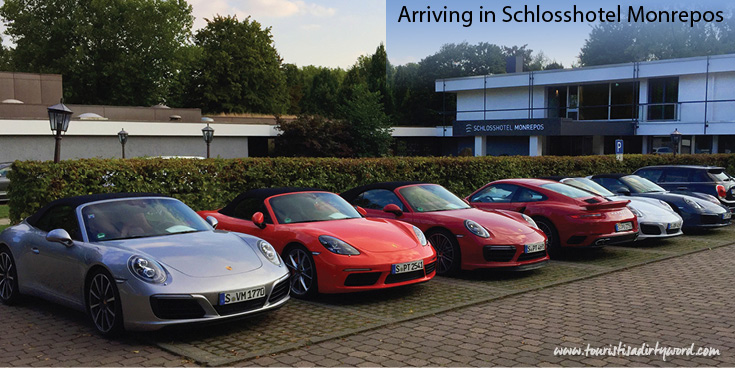
It is even more impressive to see another row of Porsche cars parked about 30 feet away.
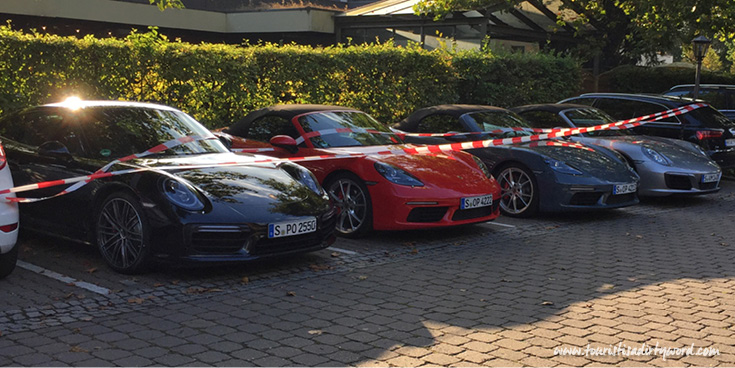
However, the absolute kicker is to see your name on a piece of paper on the dashboard of a Porsche before you go to dinner. Something great is going to happen the next day.
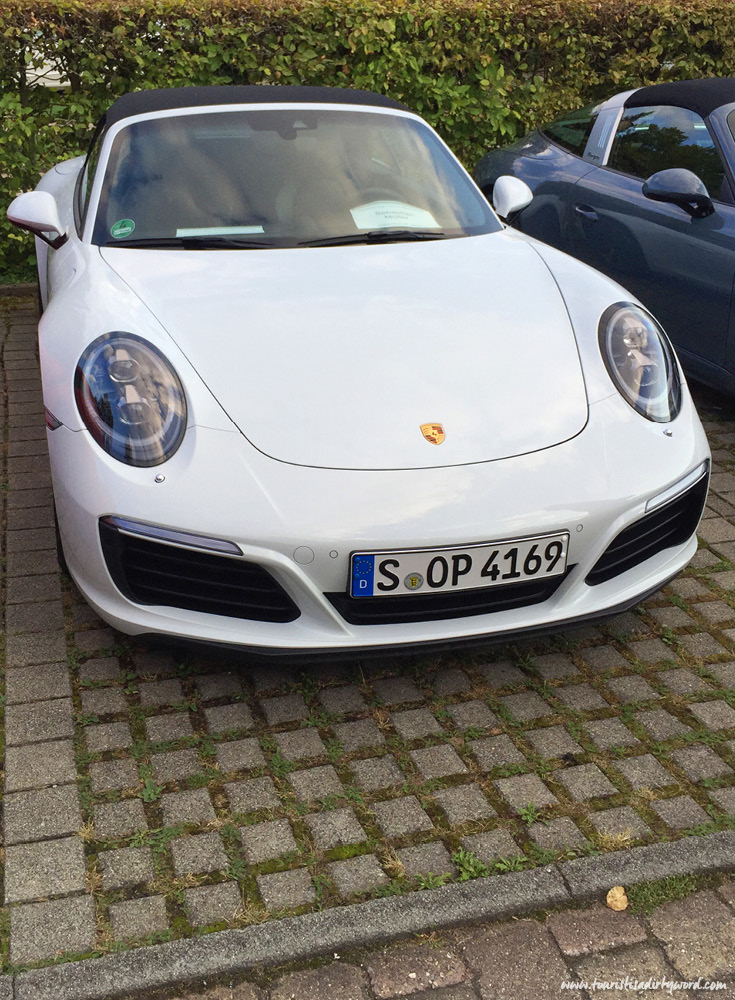
Our car was a white 911 Carrera 4S Cabriolet, and I could not have picked it any better. Most cars were convertibles with the rest being 911 Turbo coupes and a Targa model. Although the Turbo model has more horsepower, built to win on the track, I prefer having no roof over my head when driving. Even though mornings were cool with temperatures around 45 degrees Fahrenheit, climbing to 65 in the afternoon. The forecast promised sunshine and barely any wind for the next day, so my Dad and I both knew that the top would stay down all day, even if we have to use the seat heaters for a while.
When my phone alarm woke me the next morning, I jumped out of the bed, took a shower and met my Dad for breakfast. The selection was overwhelming at first and I ended up with a total of four trips to the breakfast buffet at Schlosshotel Monrepos.
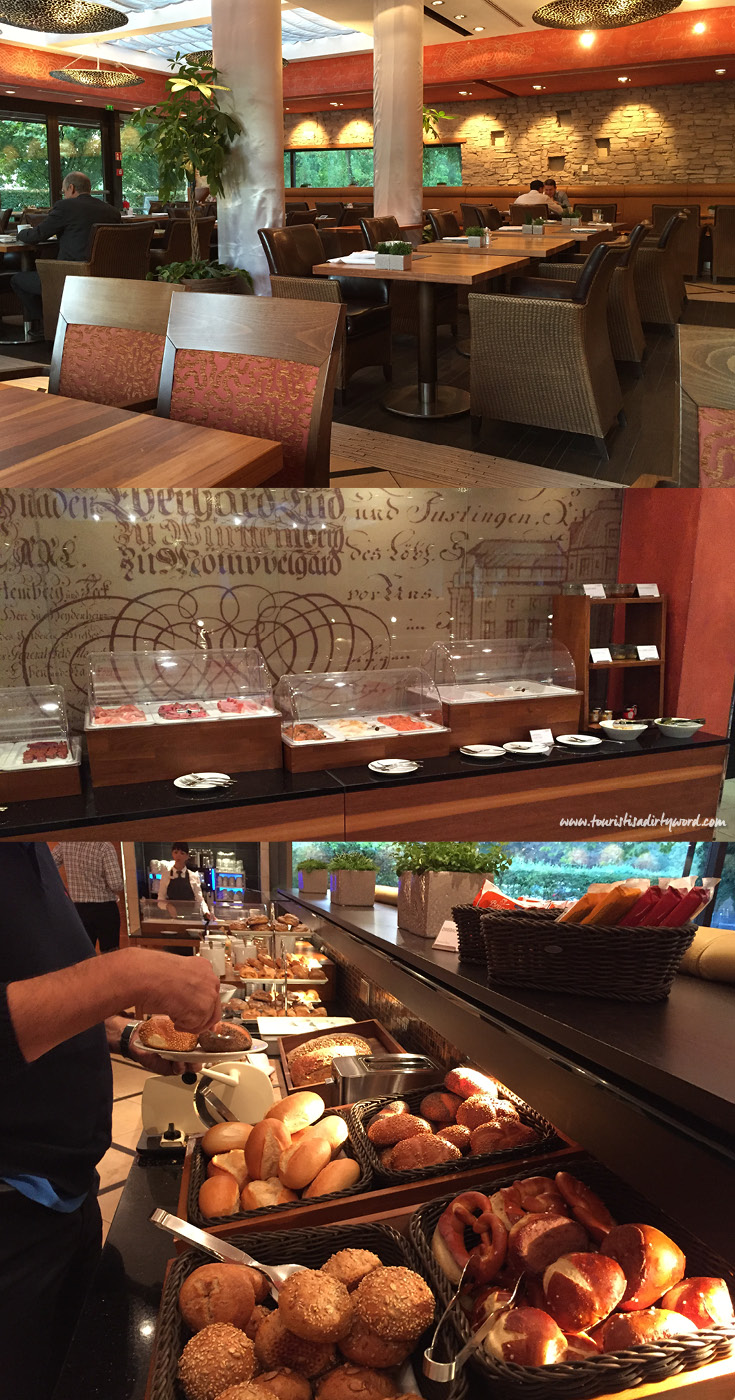
We picked out a table by the window and a waitress took our drink orders. Not only did they offer all kinds of specialty coffees, we also received a whole bottle of water instead of just a glass. On my multiple trips to the buffet I discovered chocolate-filled croissants, cold cuts, rolls, and a warm-food section with eggs, bacon, sausages and more. It was the perfect start to our Porsche morning, and I can highly recommend for you to stay at the Schlosshotel Monrepos in Ludwigsburg if you are in the area.
Morning Briefing & Paperwork
After our breakfast we walked back to the hallway and found a sign directing us to a meeting room for the Porsche Day Tour of Zuffenhausen. We were greeted by three enthusiastic instructors, who led us to our seats at a U-shaped conference table. Before you get near a Porsche car key of any kind, you will have to sign several pages of paperwork. Not fun, but the whole process took under 5 minutes.
Besides a Porsche Pen, there was also a bright red Porsche lanyard on the table with an ID card attached. One side had our names, date and tour on it, the back side had the cell phone numbers of two instructors in case we get lost or have an emergency during the day. One instructor led an English speaking group, the other one led the German speaking group. Participants kept trickling in, and it took 20 minutes until everyone had arrived and filled out their paperwork.
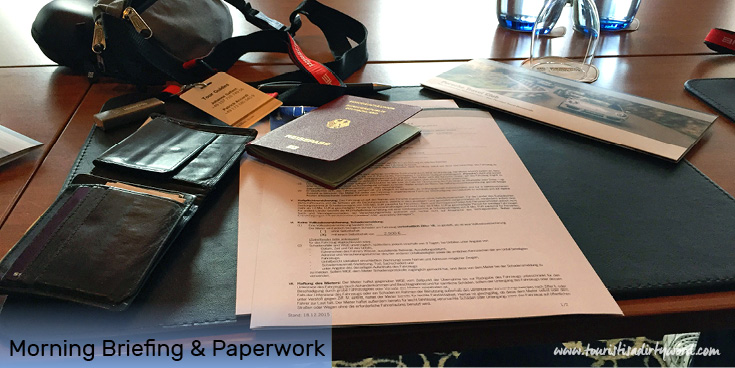
Now it was time for a briefing of what we could expect the rest of the day. The plan was to depart around 9:11 am to drive to the Porsche Museum and park there. After that we would tour the Porsche factory, have lunch, tour the Porsche Museum and finally hit the road with our cars for the day.
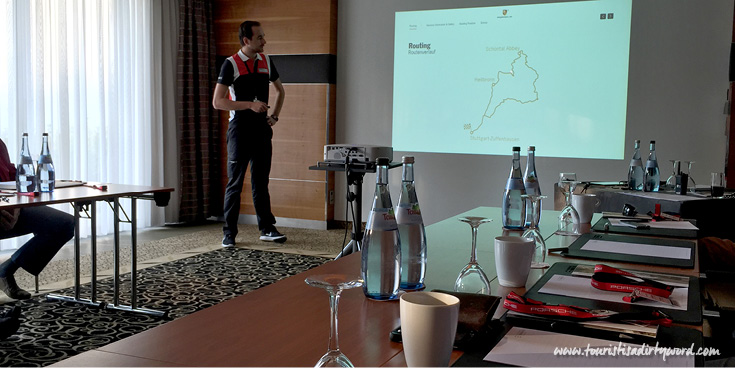
Don’t Touch That Button
We were introduced to several special buttons in the cars, the most famous one being the PSM button. By pushing this button you disable the Porsche Stability Management, which is an array of electronic controls all working together to ensure a better stability for the car. We were told to never touch that button, or to even think about touching it. The chances of crashing the car is much higher without all the electronics enabled and if we should have an accident during our trip, Porsche will read out the electronic logs. If they would find the PSM disabled, the insurance coverage we just signed would be void. For a moment I see myself in an accident with the beautiful, white Porsche, but that terrifying thought quickly dissipates when the instructors announced the end of the presentation. They would meet us at the cars outside for a final overview of all the functions and features, and also to check if the car has any nicks or dings.
The chilly morning air hits me in the face, but my adrenaline is pumping to help warm me up. We stride towards the cars. The morning dew has been wiped off the car windows already. Our Porsche was the only white one and we walked straight to it. My biggest fear at the moment was that someone could have switched the name tags around since last night, and we would have a non-convertible. Thankfully, that did not happen and our names were still prominent on the dashboard.
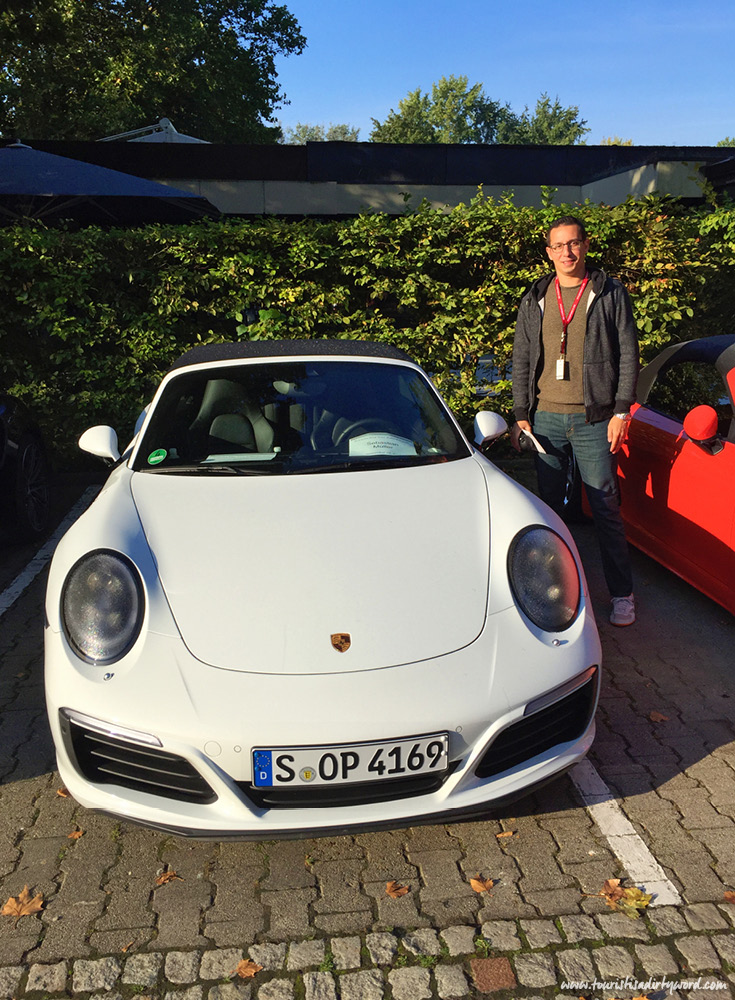
I tease my Dad that his name is located on the passenger side, but he just smirks. He’s as excited as I am, and we open the doors to sit in the car.
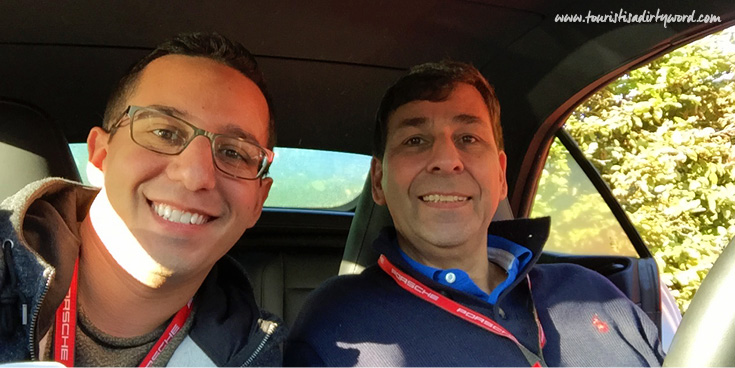
The interior is spotless, like it was just picked up from a dealership. We find out later that almost no car in the fleet has more than 10,000 kilometers (6,213 miles) on the tachometer. Once they reach 10,000 kilometers they are sold and new Porsche cars are bought. We find a walkie-talkie radio for our motorcade communication, and two water bottles with Porsche Driving Experience logo in the cup holders. On the seats is a goody bag for each of us. I had originally planned to buy my Dad a hat or shirt with a Porsche logo on it, but Porsche beat me to it. Here are all the keepsakes we received:
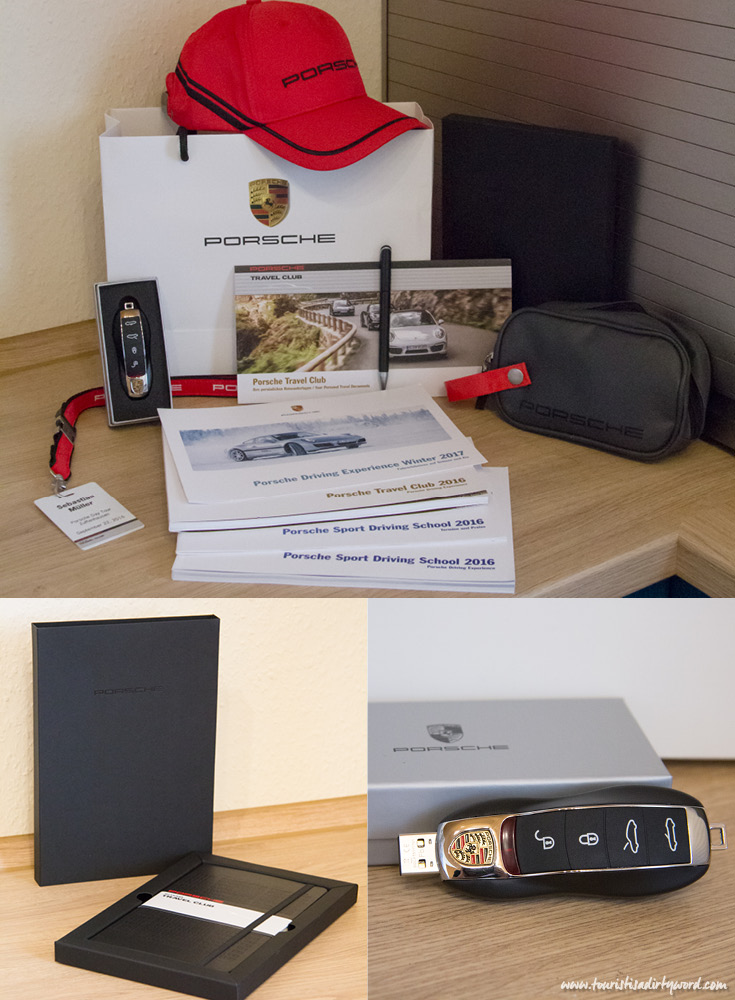
Our instructor Johanna walked around the cars with each tour participant and looked for previous damages or imperfections. Our car was perfect and we hoped to keep it that way. A quick radio check confirmed that everyone had their walkie-talkie in the car and knew how to use it. It was the job of the passenger to keep the radio communication going, so the driver could concentrate on the road. After a moment we receive the radio transmission from Johanna to start our cars and follow her. With a stomach full of good food, the convertible top down and the sun shining on our head we leave the beautiful park area around the hotel and head for downtown Stuttgart. Our motorcade of six cars roars towards the German Autobahn, we are in the 5th car.
It was a busy Thursday morning with heavy traffic on the roads, and as soon as we were on the Autobahn, our instructor sped up. It is a first glimpse of what is to come in the afternoon and cars 4 through 6 get cut off by other cars on the road. After several minutes we get the chance to catch up to the rest and leave the Autobahn with the complete motorcade heading into Stuttgart.
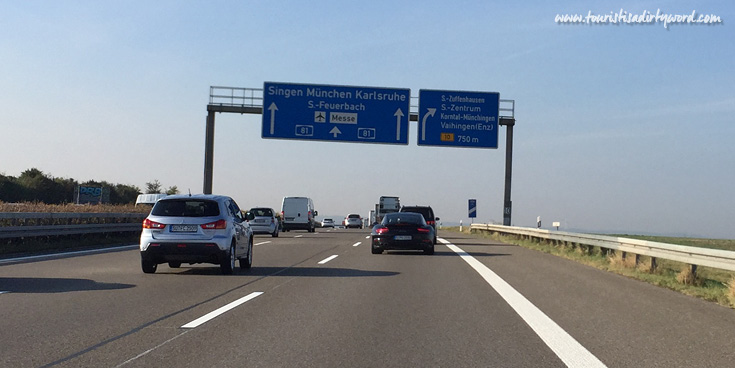
In the city, I notice the turning heads of pedestrians and other drivers. It is not unusual to see a lot of Porsche cars around this area, but a formation like ours is an eye-catcher. Car #4 in front of us does short sprints whenever there is a bit of distance between them and the car ahead. The engine sound barrages through the streets with every kickdown of the gas pedal. This is the perfect day to catch a red stop light just to take off again.
We arrive at the Porsche Zuffenhausen complex and drive towards the Porsche Museum. I expected to park in a garage or in a lot, but to my surprise our group has special parking privileges right in front of the Porsche Museum entrance. My Dad backs the car in as museum visitors grab their cameras to snap pictures of the Porsche parade rolling onto the plaza. Once parked, all of our tour members take pictures of the cars while discussing which car is the best of the bunch.
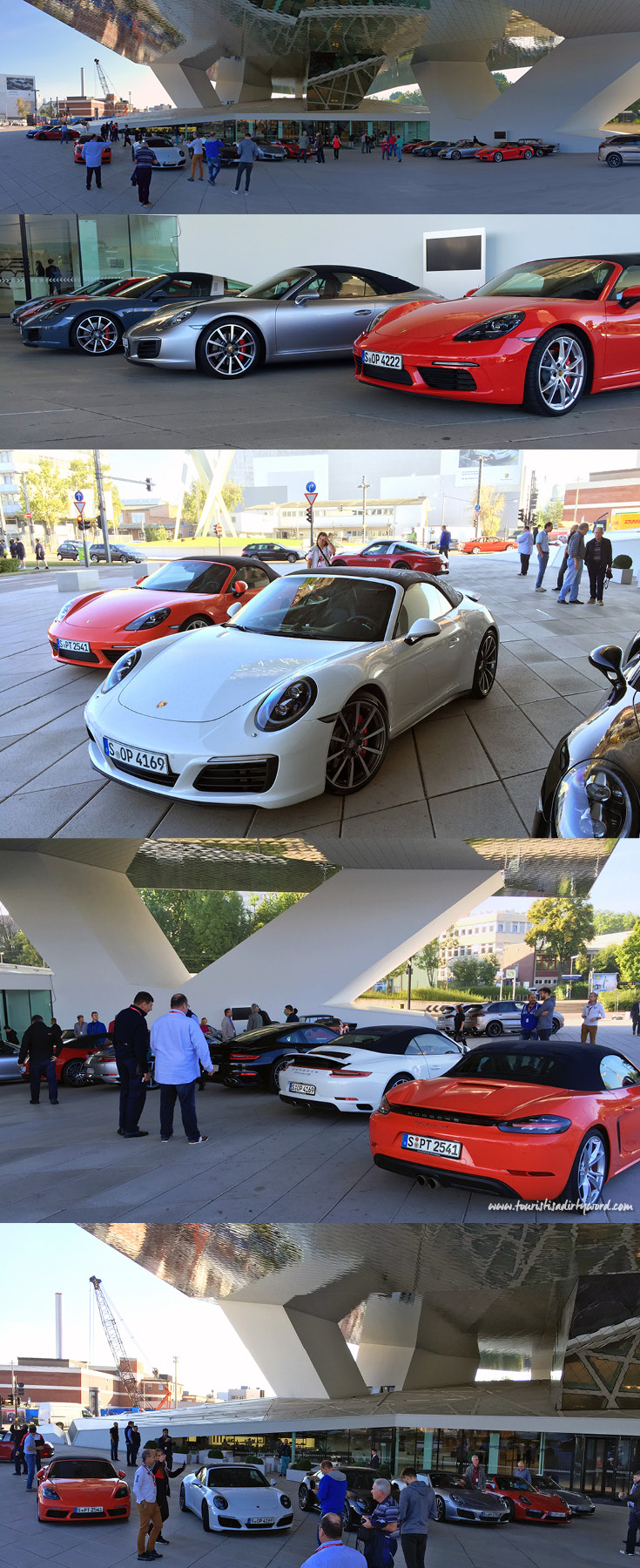
Porsche Factory Tour
It feels like an eternity waiting for our tour guide who will take us into the production halls of Porsche. All of us hurry inside as soon as we get the signal from our instructor Johanna to gather together for an introduction. A young guy in his early twenties, dressed up in a perfectly-fitting suit, introduces himself and collects all of our cell phones and cameras. This is a huge bummer, I wanted pictures for this blog. Industrial secrets trump my disappointment and I surrender my cell phone. However, there are several pictures of the production on the Porsche Press website, which you will see below. I have also linked a video at the end of the article, that takes you through most of the factory parts we did see on the tour.
Our group starts walking and we cross the street over to the plant. Each day, there are 240 cars produced in the Zuffenhausen plant, which has limited space due to its downtown location. Our guide points to the building across the Porsche Museum and explains that this is where body construction and paint process is housed. This building is not included on our tour, as there are too many fumes and too much risk of paint damage with a tour group waltzing through.
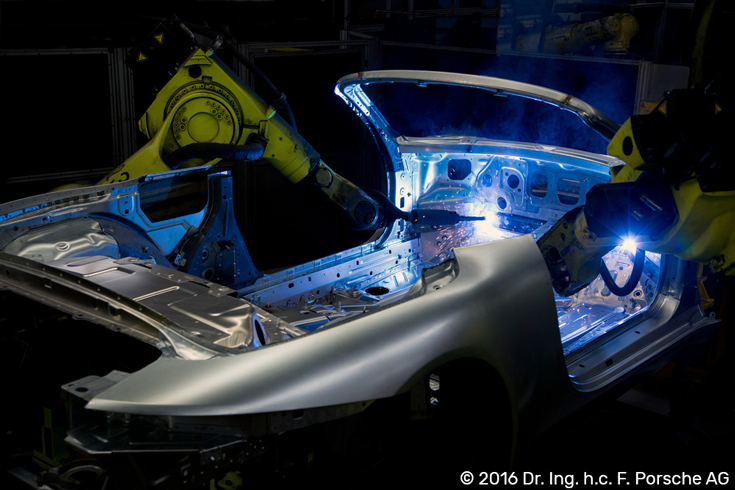
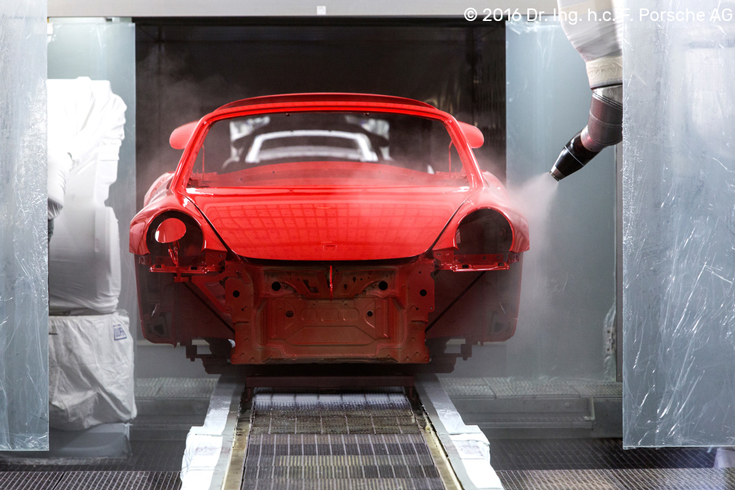
After the painting process the car has to move over to the next building. The only problem is the busy street separating the two buildings. Porsche built an enclosed bridge where all painted bodies are moved into the assembly building.
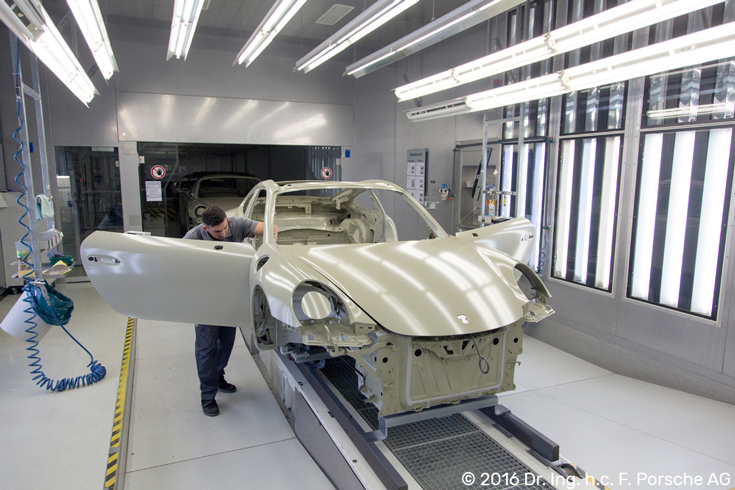
Our tour starts in that assembly building and we are immediately warned to watch out for driving robots. Colored lines on the floor act as guidelines for the robots that bring parts to each assembly station. It is called JIT - just in time, and has an anecdote that goes with it. Porsche needed to streamline their car building process, and looked for a solution when they visited the plants of Toyota in Japan in the 1990s. Toyota had already adopted a ‘lean production’ principle, where it worked closely with part suppliers to ensure their factories received parts exactly when they were needed on the assembly line. Porsche followed this principle, and this has saved valuable storage space, reducing Porsche’s costs and improving throughput.
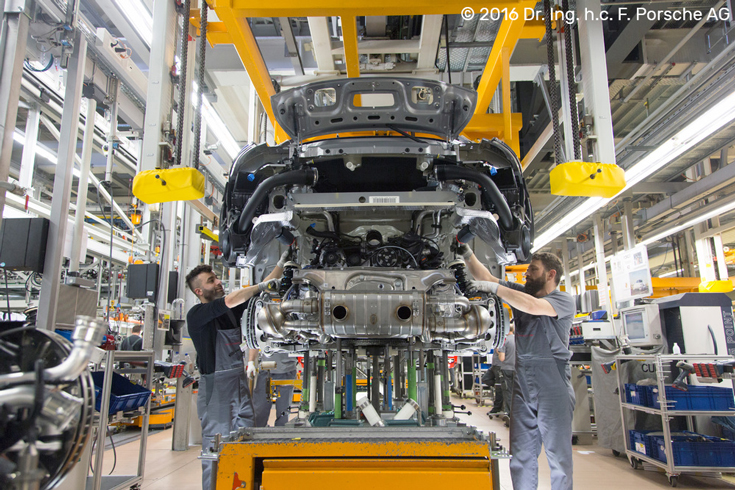
In order to have great communication with their suppliers, Porsche requires your car order to be finalized 8 days before production. No changes can be made after that time. All the parts needed are binding orders from the suppliers and shipped to the Porsche plant the day they are needed. Another important aspect that our guide pointed out, was that only the electrical wiring needed is put into the car. For example, if you order your car without the electric seat option, the wires for the electrical seats will not be part of the wiring harness. This saves cost and weight on the cars. On the other hand, if you decide years down the road to add electrical seats, you or your mechanic will have a lot of rewiring to do.
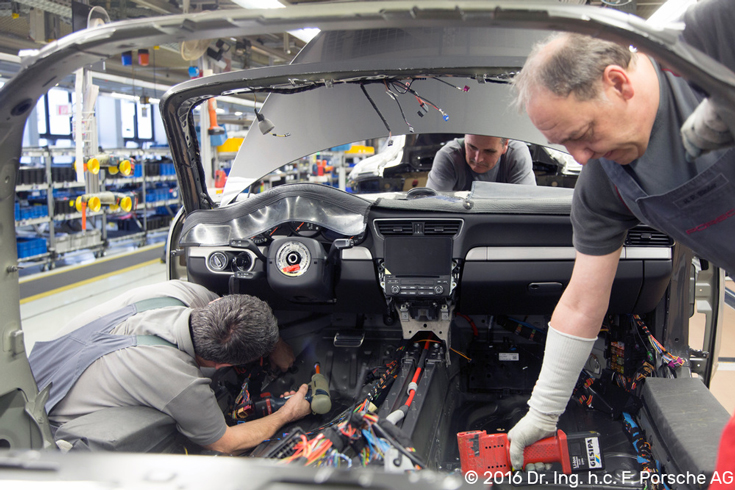
All the employees we passed seemed happy and content, no one was hurried or seemed visibly stressed. Each station has about 3.5 minutes to finish their task before the car moves on to the next station down the line. We are told that all employees at Porsche are specialized workers. There are no students, apprentices or interns on the line, in order to make the best product with the least amount of mistakes possible. It would be a daunting task to concentrate on the same thing for 8 hours per day, which is why Porsche employees have not only a morning, afternoon and lunch break, but also a 5-minute break once per hour. Their work week is also limited from Monday through Friday. There is no work on Saturday or Sunday at Porsche.
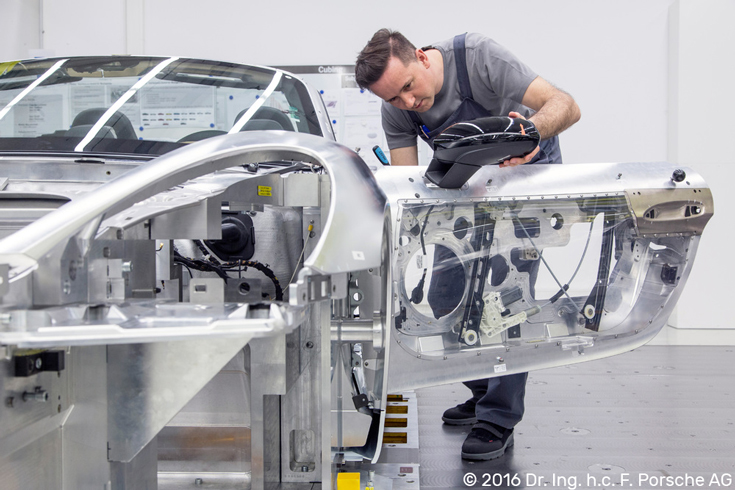
Once a week every Porsche employee can ask for a 22-minute personal break, also. Along the assembly line are two differently colored strings at each station. One is an emergency pull that stops the whole assembly line and alarms emergency personnel that someone might be hurt. The other string is the 22-minute personal break. Pull it and an extra Porsche employee will jump on a bicycle and drive to your station. He will take over your tasks for 22 minutes until you return. If unused, the 22 minutes expire and you get another 22 minutes the next week. I was hoping someone would pull the personal break string during our factory tour, but no one did.
Toward the end of the assembly line, all buttons and electronic functions are checked by several employees. The car is hooked up to a computer and two or more employees press every button and flip all the switches in the car. With that many people hopping in and out of the car, the paint is protected by clear body covers to avoid scratches and dings. The doors have been taken off the car at the beginning of the assembly line and are delivered back to the exact same car at the end of the assembly line. This ensures that workers have enough space to work inside and outside of the car, for example when they maneuver a completely assembled dashboard into the car. Right before the doors join the rest of the car, the wheels are mounted.
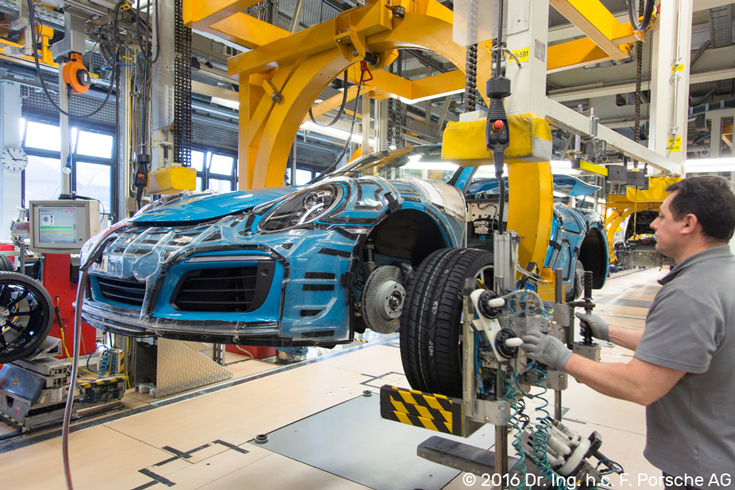
At the end of the assembly line our guide explains that Porsche only produces cars when ordered by a customer through a dealership. Porsche does not build extra cars for inventory. The current production time ranges from 3 to 15 months after your order has been finalized, depending on the Porsche model ordered. Talking about models: If you order a Panamera, Cayenne or Macan model, those will be built in Leipzig, Germany since there is more space to build the larger cars. Zuffenhausen builds the Boxster, Cayman and 911 two-door cars.
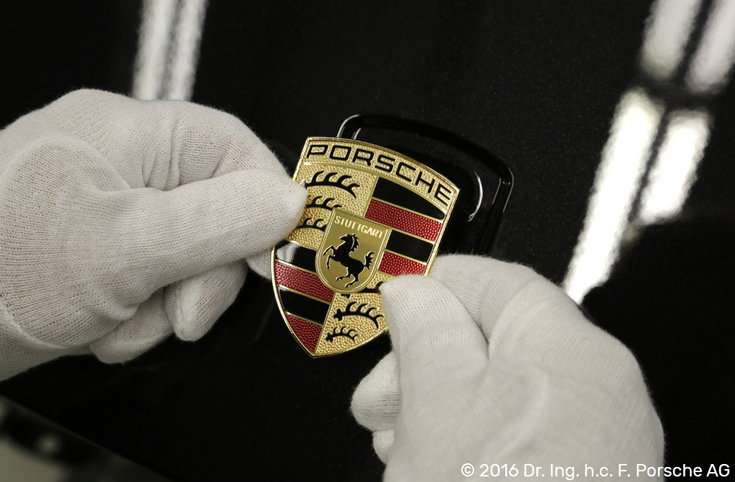
After we saw the whole car assembly, we walk to the next building where the saddlery is located. Before we enter, our guide shows us a large piece of leather, which has to go through a scanner first. The scanner finds any imperfections on the cowhide and cuts the sizes needed with a water jet cutter. I am amazed when he tells us that it takes an average of 8 cowhides to completely upholster a Porsche, since about 50% of the leather has imperfections and will not be used on the cars. Still amazed by the number of cowhides used, we enter the saddlery rooms. High humidity hits me in the face as I pass through a curtain of clear plastic pieces. The humidity helps to stretch the leather and we pass several stations, starting in a sewing room and ending up in a room where dashboard and other interior items get their protective leather covers.
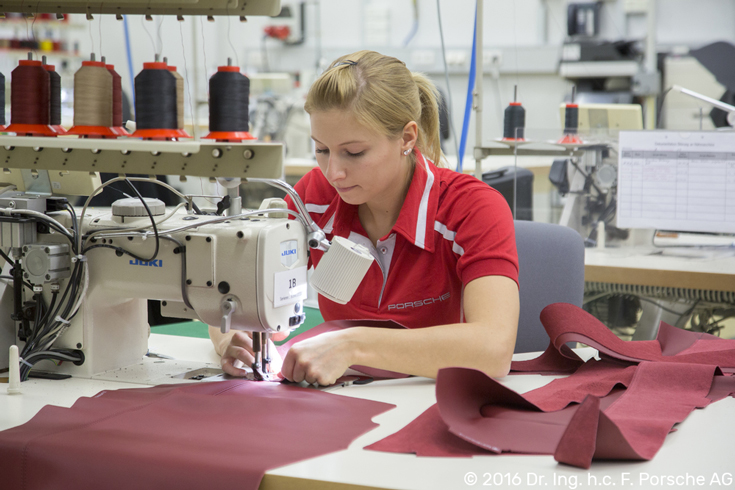
The JIT - just in time principle also applies here. Customers can choose from more than 10 colors of leather and all the pieces delivered are accounted for. The sewing workers have ample time to finish their seams, while on the other hand Porsche expects them to make no mistakes. If a mistake is made, it could result in having to re-order the affected leather pieces and the finalization of the car might be delayed.
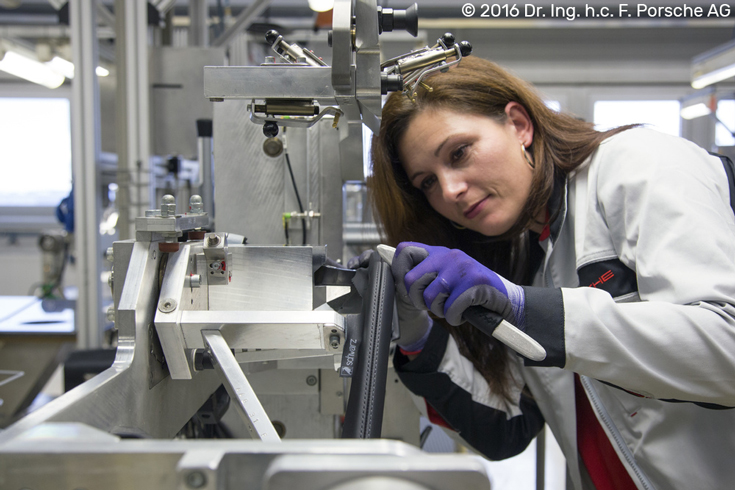
It is incredible how much manual labor goes into each and every Porsche. Besides the robots driving parts around and some robots on the assembly line applying glue to windows, there are no other robots around. Most of the labor is done by human hands, which is something I did not expect. It justified the high price tag of Porsche cars for me. I could not wait to jump back into our car for the day to see all the elements together.
Porsche will also fulfill special orders, assuming you have enough money to back the order up. Seams can be pretty much any color you like, your family crest can be stamped into the leather if you prefer, and if you would like parts of your seat to be alcantara, a man-made fabric, instead of leather, no problem. Other wishes, such a paint calipers in a certain color or body modifications, can be taken care of in six specialized bays on the north end of the Porsche complex.
Our final building was the engine factory, which was at first a large storage warehouse. Components and parts for the production of all Porsche engines are stored here, most parts will be used up by the end of the day. Workers pick the parts and put them on a driving robot, which then brings it to the engine assembly line in the next building.
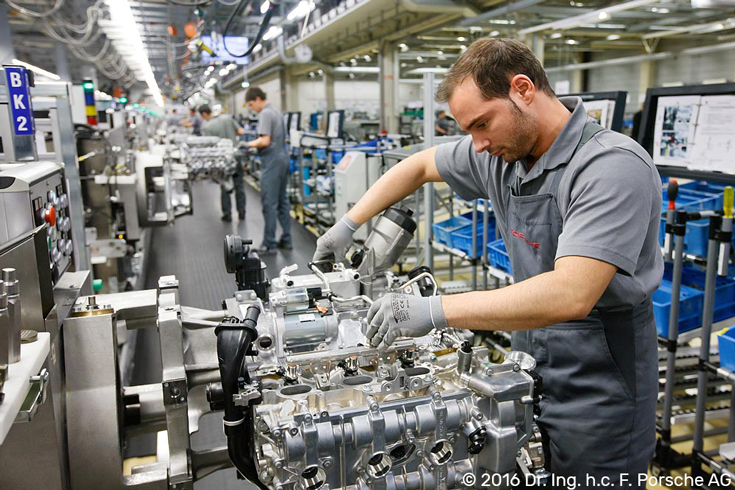
All Porsche engines are built in Stuttgart on two separate assembly lines. One assembly line is for the flat six engines and the other one is for the V engines. It takes about 4.5 hours to build a flat six Boxster and 3.5 hours to build a V8 engine. All V8 engines are shipped to the larger factory in Leipzig, where they are inserted into the larger vehicles. At the end of each assembly line is the EFT (End Function Test) where the engine gets tested before it gets shipped to the car assembly line. It is amazing to be this close to the production of the engines, even though we are tired of walking so much already.
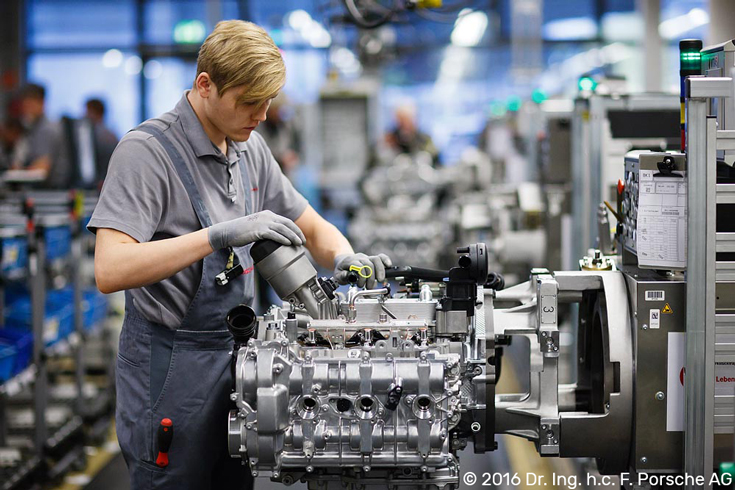
We leave the engine factory and our guide walks us back to the Porsche Museum, where we get our phones and camera back. This is the end of the factory tour and Johanna takes over again. She leads us to an elevator in the back of the museum and we are off to have lunch at the Christophorus restaurant. The elevator doors open and we walk along a corridor with a big window on one end.
Lunch at the Christophorus Restaurant
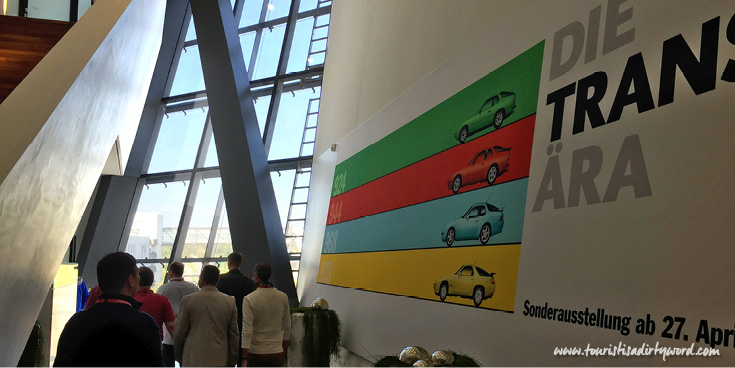
From here you have an amazing view of the Porsche sculpture in the middle of the roundabout. In the background you can see the enclosed bridge that transports the painted car body from the left building over to the assembly building on the right.
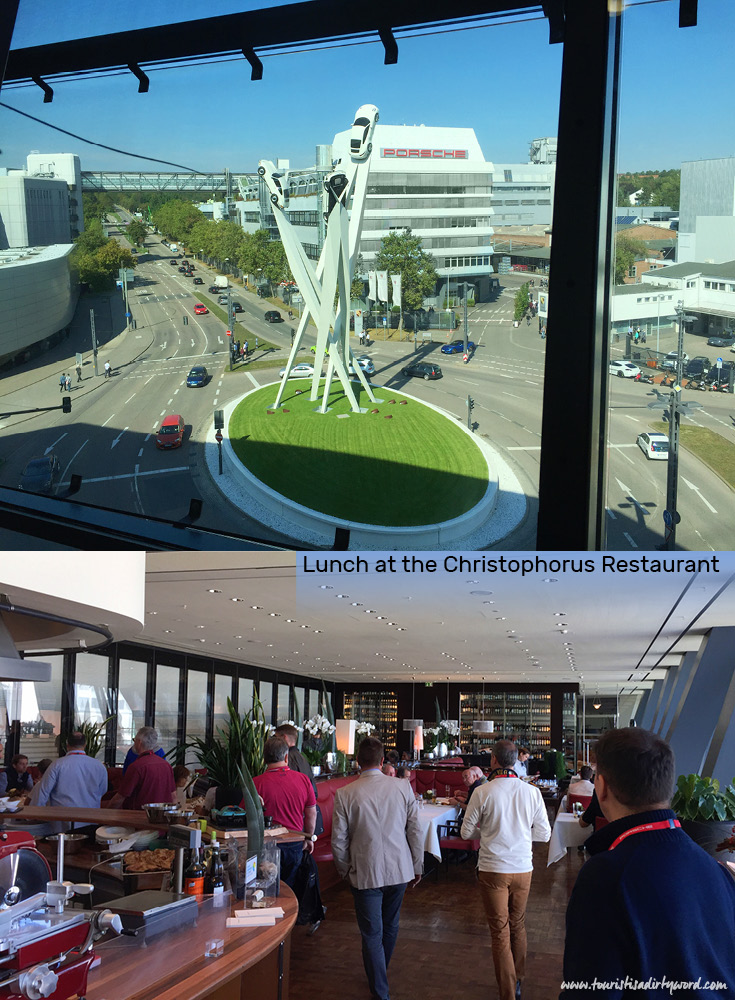
Half of the group pauses for a photo, while the other half cannot resist following the great lunch smells and head directly into the restaurant.
Our group almost seems a bit underdressed, the Christophorus is a fine dining restaurant with plenty of staff members. One of our waiters is serving everyone water, and asks if we want water with or without bubbles. During our lunch he quietly refills every glass that gets to the halfway mark of being empty, remembering everyone's preferences. He never needed to asked any of us again which water we prefer. Simply incredible how he remembers.
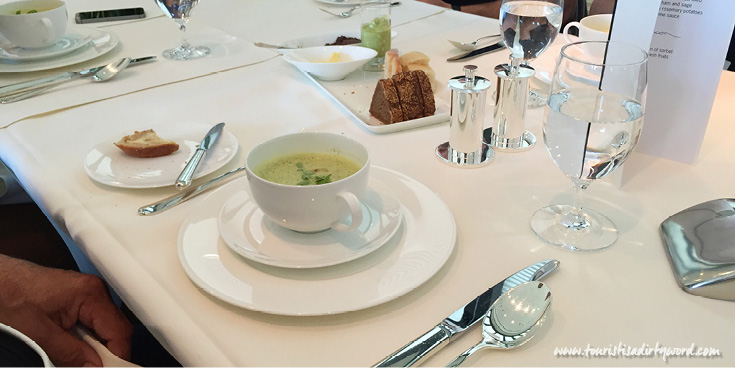
One of the waiters brings assortments of breads and butter over to the table, followed by the first course on the menu, a lime-cress cream soup. I am not a big fan of soup as a general rule, but I eat some of it.
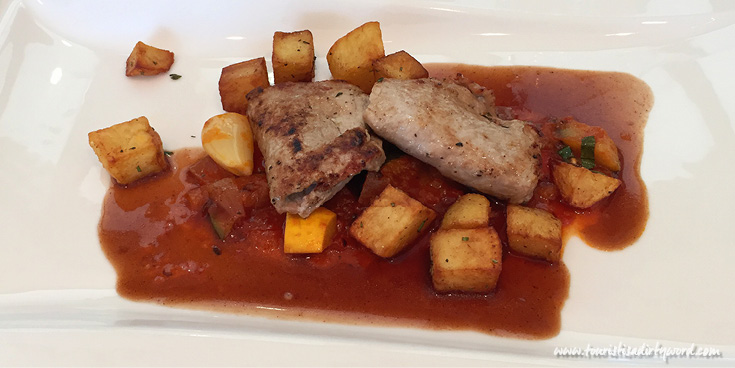
Our second course is a filled veal, which is one of the most tender veals I have ever had. Now I am glad that I did not finish my soup.
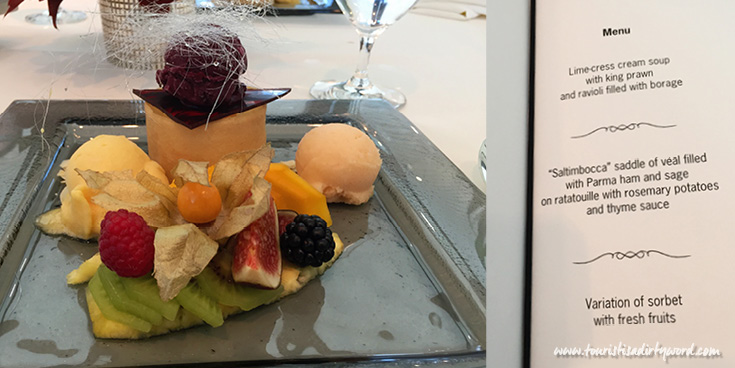
And for the finale, a stunning assortment of sweets. Homemade sorbet, chocolate, and some fruits. We were also asked if we wanted a coffee or espresso to go with that.
We left the restaurant happy and full, excited for the next event which was a guided tour through the Porsche Museum.
Porsche Museum
We met our museum guide near the entrance, and each of us received a ticket and a headset. The tour started on the ground floor where we looked into the workshop. A handful of mechanics work on all kinds of Porsche cars year round.
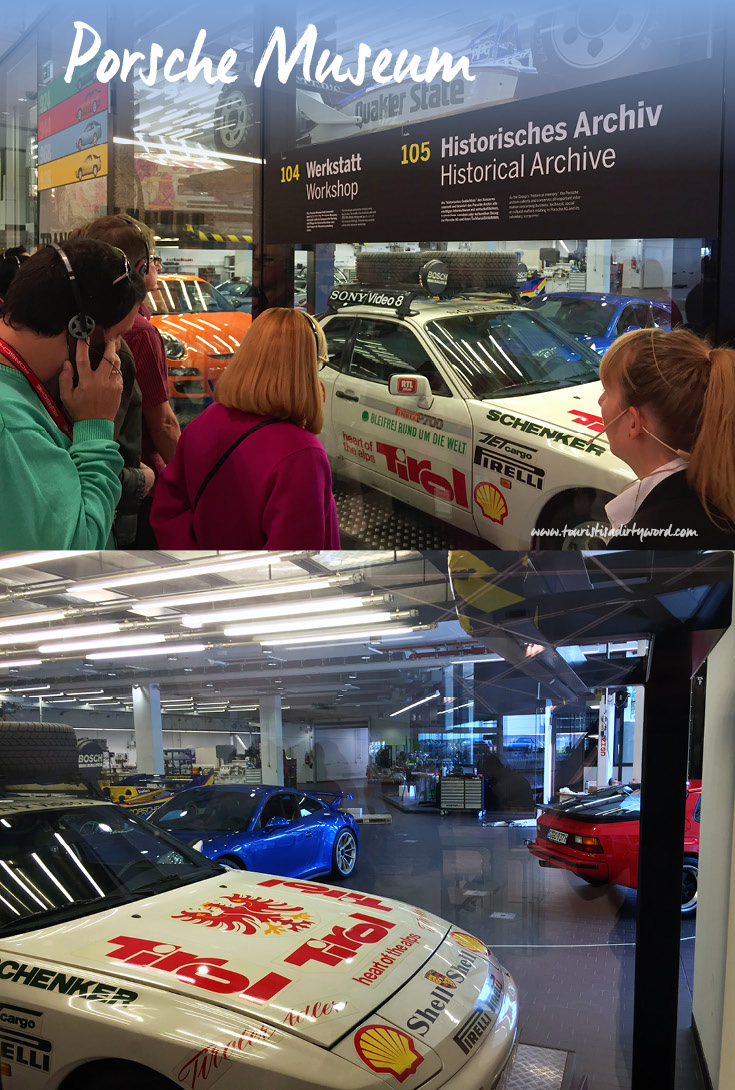
Supposedly every car in the museum is fit to drive and before it hits the road for a race or an old-timer car meet, the car gets inspected and worked on right there in the workshop. Then our guide takes us up an escalator into the actual museum showroom. The walls and floors are kept in white, everything seems very modern and structured.
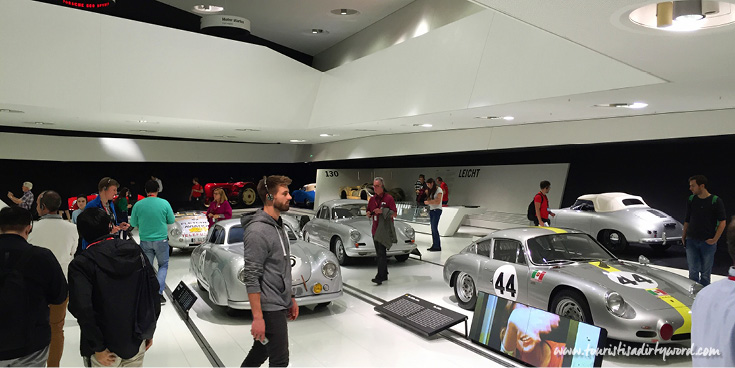
The museum starts out with the history of Porsche, beginning in 1931 when Ferdinand Porsche initially offered motor vehicle consulting, and moves on to how the Porsche family’s three generations have evolved from engine development to car body designs. Along the way, Porsche has created some of the most memorable cars in history.
In 1934 he had received the contract to design and build a German ‘people’s car’ as part of the government’s plan to motorize Germany. Ferdinand Porsche did deliver, he designed the Volkswagen Beetle, which was later produced by Volkswagen from 1938 until 2003.
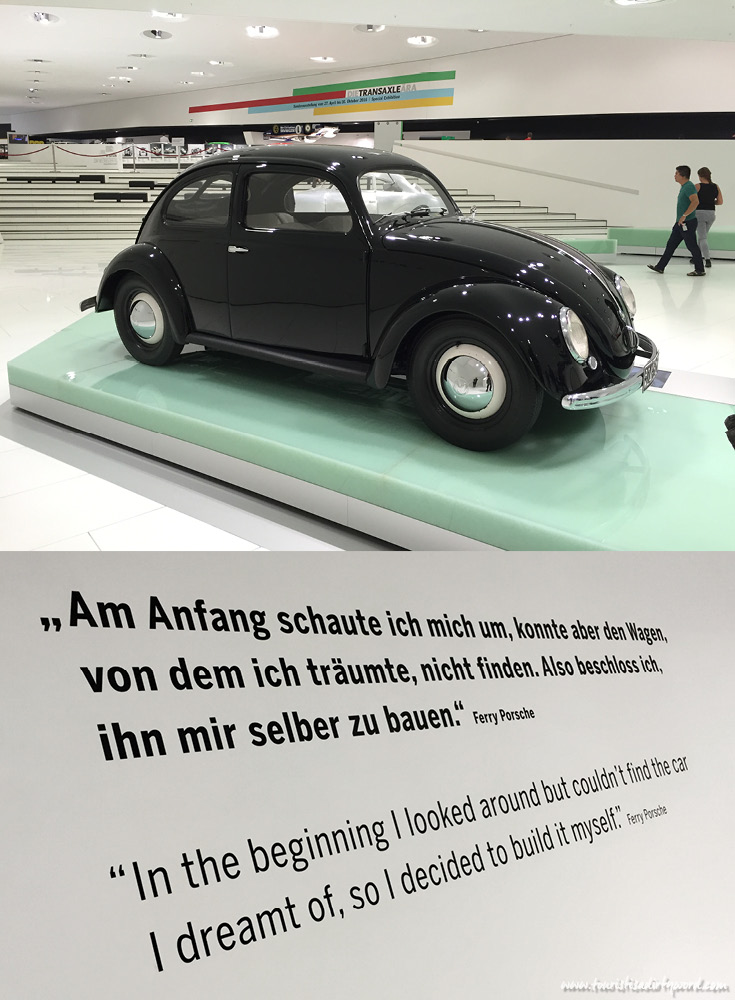
There are about 80 cars on display all the time, ranging from the first Porsche 356/1 to the most up-to-date model 911. You are not allowed to touch the vehicles, but you can get very close in order to see all the beautiful details.
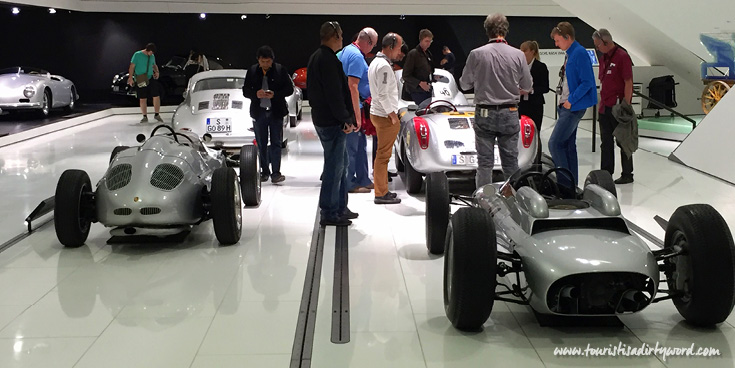
Did you know Porsche also designed and built diesel-engines for tractors? In 1937, Adolf Hitler was looking for companies to develop a small agricultural tractor that was cost-effective, easy to operate, and robust for farm work. Porsche designed and developed an air-cooled two-cylinder engine with 11 horsepower. Only test mules/tractors were produced, since WWII had started. After the war was over Porsche cooperated with the Uhinger and Mannesmann automotive group to actually produce the tractors before they sold the tractor business to French car maker Renault in 1963.
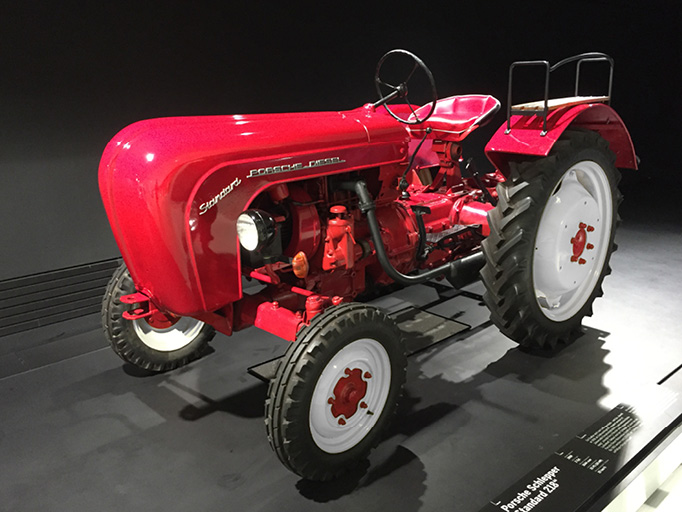
My personal highlight from the museum was the return of a race car which had been at a race event the weekend before. The technicians had checked the car downstairs, cleaned it, loaded it into an elevator, and pushed it back into the exhibit, all while the museum was open and we were watching.
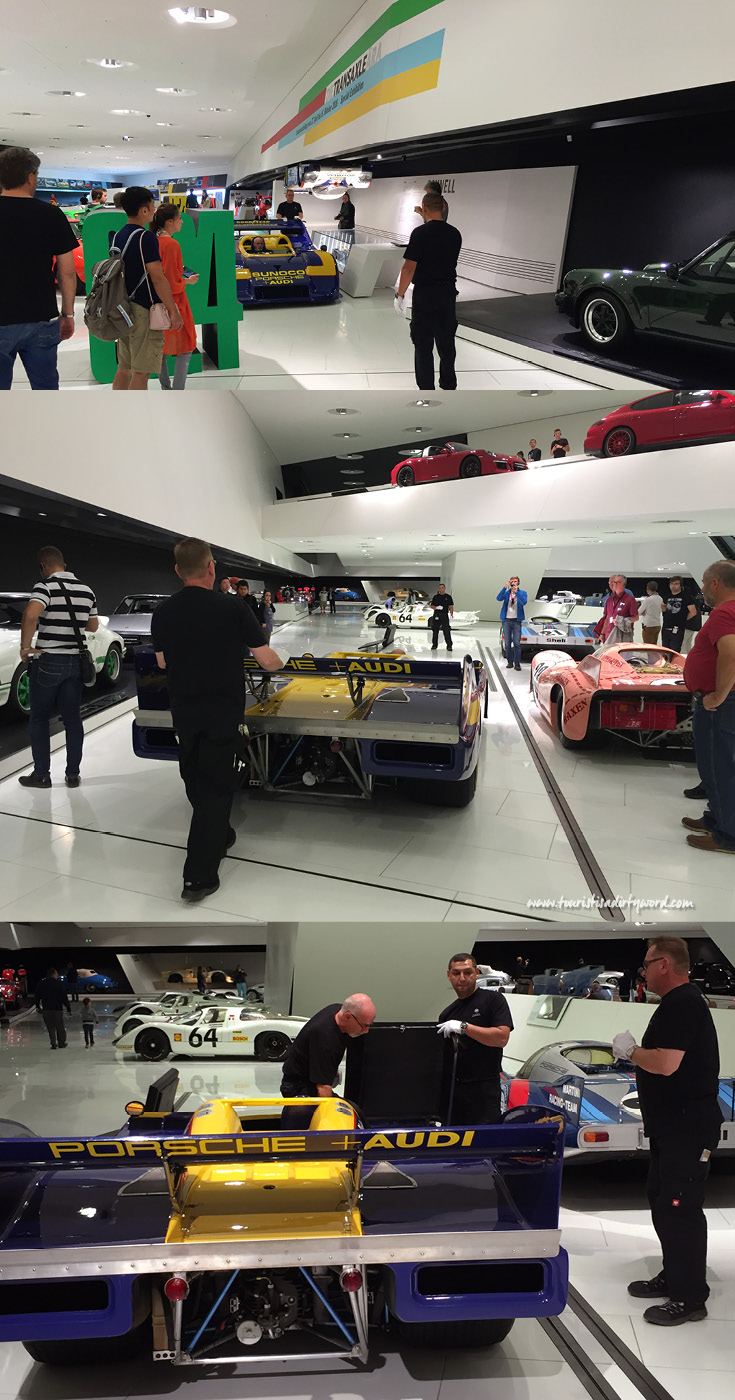
The longer we walked, the more I was anxious to get back into the white Porsche we had parked outside and hit the roads. After the tour we were given some extra time to revisit some of the cars we had seen or hit the gift shop. I found two more unusual Porsche cars that I had to snap a picture of:
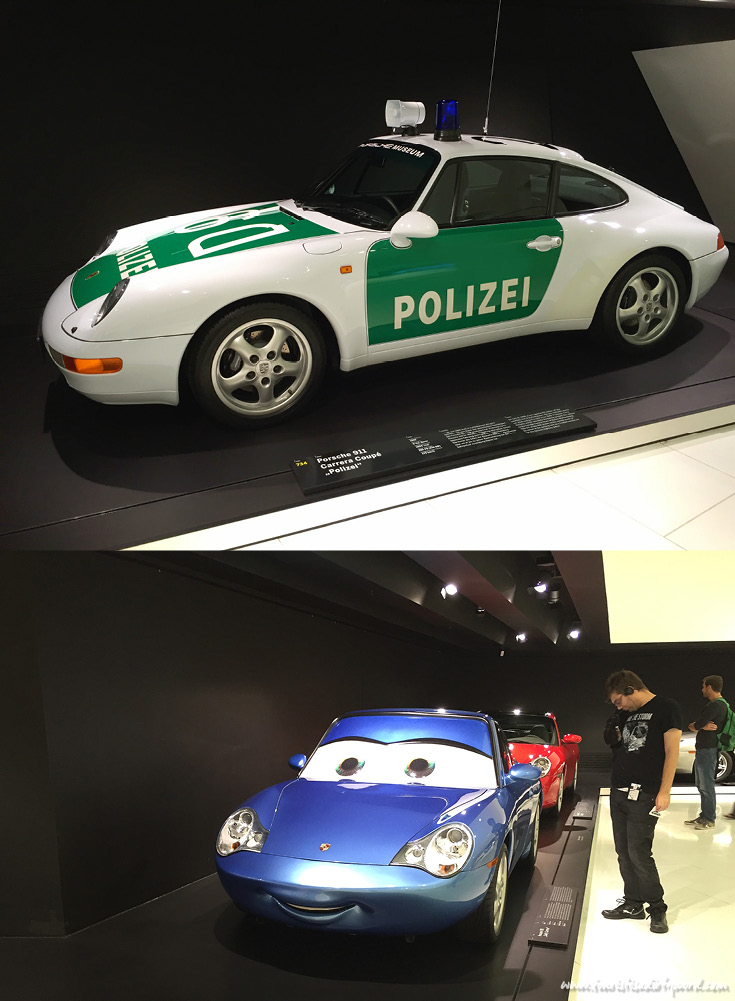
Waiting for Johanna felt like an eternity, but we used the time to look around our car’s interior, appreciating all the form and great materials we had seen during our factory tour unite in the classy cockpit.
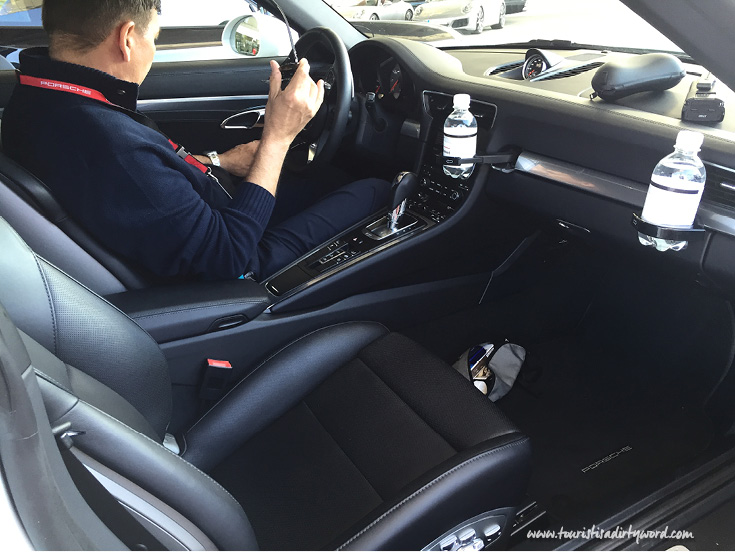
Driving Around Zuffenhausen, Germany
Johanna returns and the group is cheering as she does her radio check before we take off. Everyone knows that the fun we’ve been waiting for is about to begin. But first we have to get out of the downtown traffic and back to the interstate before we can escape to the country roads. We pull to the first stop light at the intersection in front of the museum, which turned out to be a very short light. Half the group makes it through, the other half has to wait until the light turns green again. Johanna, as always, keeps her cool and pulls over onto the bus lane, waiting for the rest of the group to catch up and communicates over the radio. How she steers, watches traffic, keeps an eye on the group and talks to us over the walkie-talkie will forever remain a mystery to me. Kudos to her, she has the whole multitasking thing down.
After we get through another busy Autobahn part, we take an exit and we’ve made it. Backroads with lots of greenery and fewer cars. When Johanna spots the first “speed limit lifted” sign, you can hear her car roar, followed by a matching roar of the second car, third car, and so on. It feels like we are on a test drive without a naggy salesman sitting behind us, watching our every move. The fact that the German weather gods had mercy by sending us sunshine and mild temperatures feels like the icing on the biggest chocolate cake.
Here is a video for you, even though the wind noise is distracting from the exhaust notes:
We weave in and out of towns where we have to slow down to 50 kilometers per hour (31 miles per hour). This seems annoying at first. We have fast cars and we want to drive fast. However, the real fun part is to pull out of the towns and spy the sign with the discontinued speed limit. As soon as we passed the sign, the whole group took off again accompanied by a wonderful engine concert.
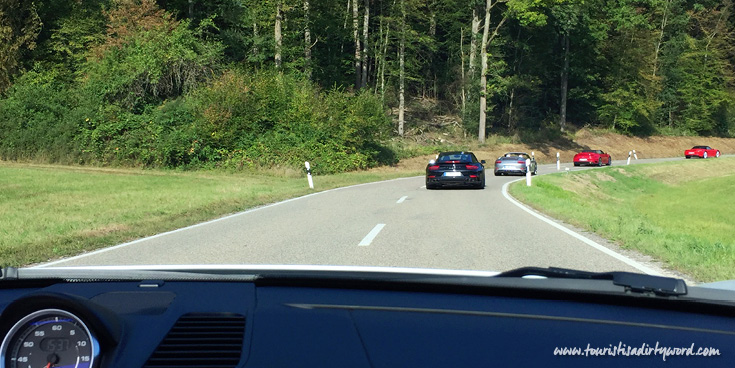
The two things we played with about 30 minutes into the drive, was the Sport mode button accompanied by the Sport exhaust button. All of a sudden the car felt stiffer, lower, and meaner... plus the crackle of the exhaust simply made my day. Every time we drove through one of the towns along the road, passersby turned their heads, listening to the exhaust symphonies of our cars. Some gave us a thumbs up, kids waved. The whole experience felt like a dream.
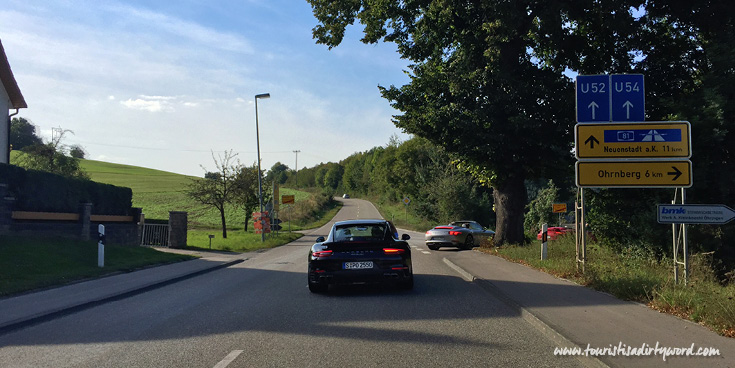
After about 90 minutes of driving we reached Schöntal Abbey and took a break. A quick glance at the baroque building is all we get, since we are a bit behind schedule. A couple of extra minutes at the factory tour, a very relaxed lunch and extra time spent at the Porsche museum threw us back altogether about 30 minutes. We walk over to an old train station building with a kiosk inside. Outside are benches and umbrellas and we all have a drink (non-alcoholic, of course) and use the restrooms. Next up is our driver change. It will be my turn to drive back to the hotel where everything started in the morning.
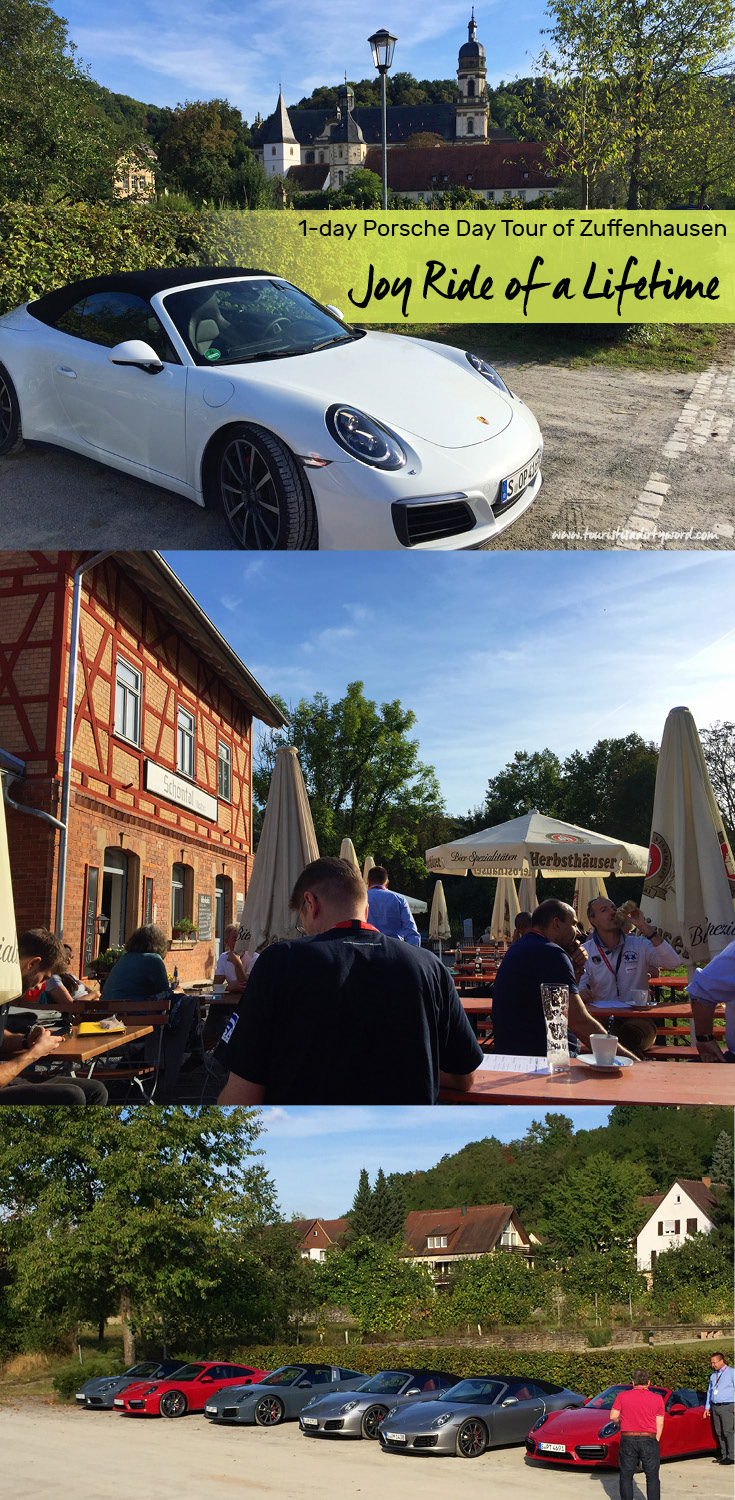
To make up time, we head back to the Autobahn and move into the left lane. Traffic is light for a couple of minutes and we speed up to 200 kilometers per hour (124 miles per hour) until we hit a major traffic jam. The area around Stuttgart is notorious for its congestion and somehow we ended up in the middle of both rush hour and road construction. You can tell that Johanna is scrambling to get us out of there and finally finds a back road we could take. She tells us over the walkie-talkie, that by taking the back road we would be an hour later than planned. If anyone has a problem with this, they have to tell her now.
Dead silence on the radios. My inner child is pleading that no one says this is a problem, I am not ready to give up this car yet! Johanna finally breaks the silence, and we take the next exit after being trapped in traffic for a good half an hour.
It is a delight to drive this car because it feels like it is glued to the road no matter what I do with it. Sharp corners or roundabouts do not phase the Porsche, even at higher speeds. Wherever you steer, the car goes and remains there. Time goes by fast and I am sad to see the signs directing back to the hotel. This day was as much a present for my Dad as it was a present for me. We bid farewell to our white roadster and take two final pictures.
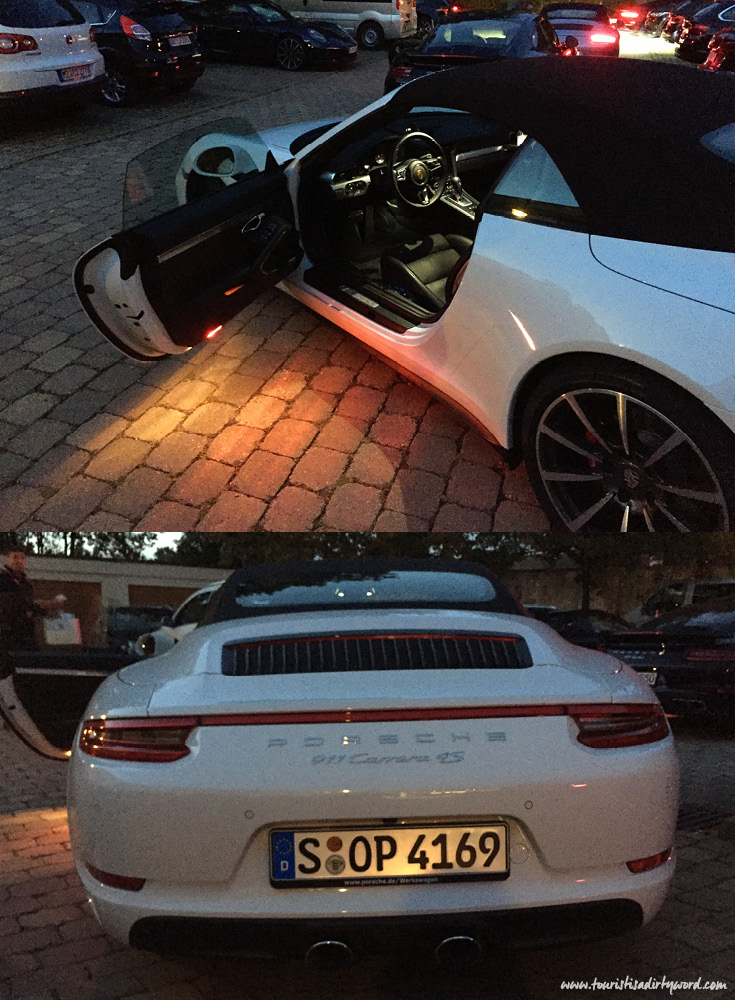
If you ever have the chance to go on a trip like this, I hope you do. For more information on Porsche Driving Experience events, check their US website here, or for their international offerings here.
Follow Along
If you enjoyed this article, or these topics sound interesting to you, you'll love our weekly newsletter. You'll receive a free Germany Packing list for signing up, and you'll receive each week's newest posts every Friday. Thank you for reading!

You have to admit, the building is impressive. It reinforces the idea that you’re about to witness man-made achievements before you even buy your ticket. I wonder if the architects were playing against the idea that you should think outside the box when they decided to literally build a modern, cold-looking, glass box, and then enclose the art in warm, Jurassic-age limestone. The new museum building was opened in 2005, and designed by architects Hascher and Jehle, the triumphant winners of a competition amongst 341 architect offices. They sought and accomplished building a museum that offered varied exhibition spaces, and felt open to the city outside. For the museum visitor, the act of changing floors is both becoming a part of the public art of the museum architecture itself, as revealed by the glass windows to passersby outside, and a visual delight with its panorama views of the city-center.
Swabian Impressionism
Thanks to Count Silvio della Valle di Casanova's donation of his private collection of Swabian Impressionist works in 1924, the Kunstmuseum Stuttgart had a hearty foundation to start. Impressionism is my favorite art period, and the ‘Swabian’ element grabbed my curiosity. What made this Impressionist collection ‘Swabian’? Swabia refers to a region of fluctuating borders within Germany, one that usually included the city of Stuttgart. In today’s geography Swabia has been swallowed up by the states of Bavaria and Baden-Württenberg.
Swabian Impressionist referred to where the artists were from, more than a different variation of Impressionism. Although some may point out that their paintings consisted of more earthy tones than their French counterparts, this was in reflection of the Swabian landscapes they were depicting. The names to know are Hermann Pleuer, Otto Reiniger, and Christian Landenberger. Hermann Pleuer, whose landscapes often included some form of rail or trains in the scene are easy to identify. Impress your friends when you name the artist without looking at the calling card.
Otto Dix
We’ve discussed Expressionism before as it related to the architecture of a special street in Bremen, Germany called Böttcherstrasse. You can check out those earlier posts here, Böttcherstrasse: An Introduction (Part 1), Paula Modersohn-Becker Museum (Part 2) Mostly Expressionist, Sort of North German Gothic (Part 3). Expressionism also has a painting counterpart, a style that Otto Dix is very well known for. He distorted the figures in his painting for an emotional effect, to express a feeling. Expressionist; expressing feeling.
Within a few seconds the elevator doors opened again and I stepped onto a walkway with a giant white horse statue leading the way. You go into a car museum and there’s a white horse statue? Before you see any cars...a horse? I’m puzzled. I find out later it's an insider’s joke at the expense of Kaiser Wilhelm II, a German emperor, who once said: “I do believe in the horse - the automobile is no more than a transitory phenomenon”. This museum will prove him wrong.
Worth It's Price, Even Twice
Over the years we have explored many museums. Some great ones, some good ones and also some rather boring ones. I’ve never personally wanted to return to any of them until Denise and I went to the Mercedes-Benz Museum in Stuttgart several years ago. I kept thinking of taking my Dad there. My Dad, like me, is a car nut. We both love anything that has four wheels and sounds great. If it goes fast? Even better!
Every other year the International Motor Show is in Frankfurt am Main, and my Dad and I push ourselves through the masses in order to get a glimpse at the newest cars. This was an off-year for the International Motor Show, and Stuttgart is only a 2-hour car drive away from my parent’s home in Germany. Perfect time to take a joy ride down to Stuttgart and show him the museum which I still thought about from time to time. If you have the slightest interest in cars, architecture or history, do not miss the Mercedes-Benz Museum.
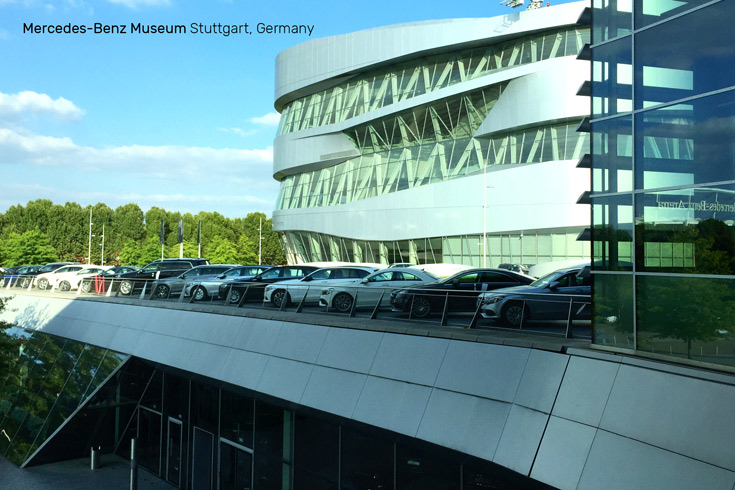
This striking, one-of-a-kind gray building with its wavy forms and massive windows, stands 47.5 meters (156 feet) tall. Looking at it from the outside it is hard to believe there are any straight walls or floors in this building with its swaying form factor. Built in 2006, you enter through large glass doors and stand in a light filled foyer, forcing your eyes to wander up to the ceiling. It is a tall building, but even at this massive size it appears airy and dynamic. Past the cashiers you can see all the way up to the 8th floor, which is also where you start exploring.
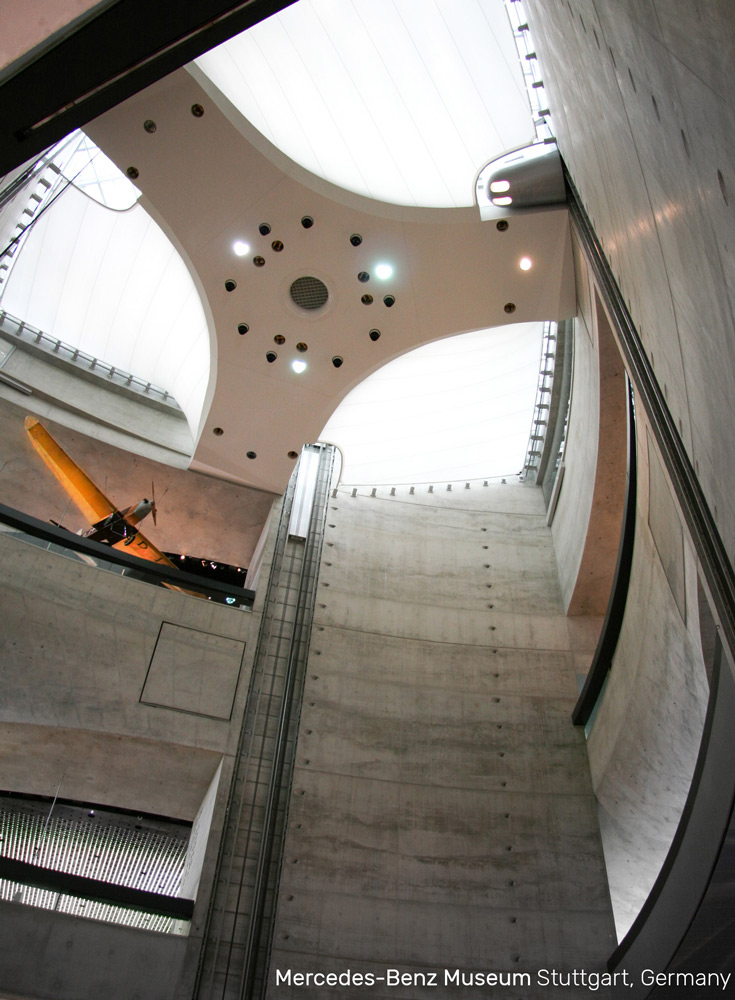
To get up there, you scan your ticket and enter one of the elevators, taking you all the way up. Even the elevators are a work of art, shooting up like a silver bullet along the cement walls. Before you enter the elevator you have the opportunity to pick up an audio guide in several languages, giving you even more information as you make your way through the museum. Personally, we did not use the audio guide, so I can not comment on them. The majority of the exhibits were bilingual, German and English.
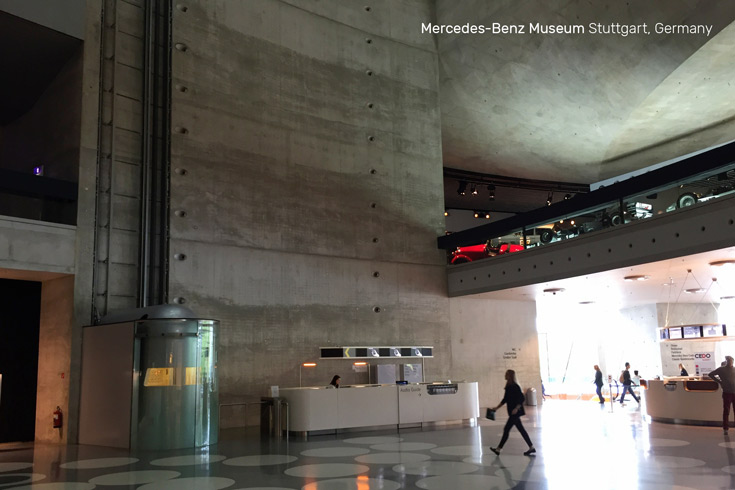
A small window in the elevator lets you peek outside where moving pictures are displayed on the cement walls. Trying to take it all in, the ride is over way too fast.

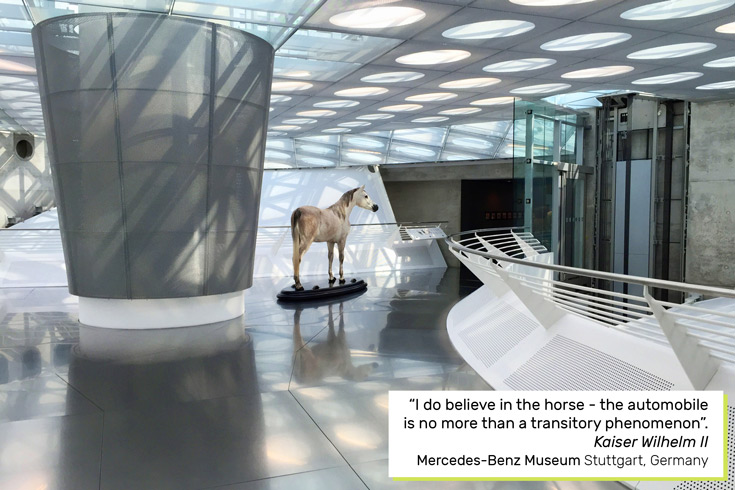
Pass the horse, you step into a large, round room dedicated to the year 1886, when the 130+ years’ history of Mercedes-Benz began. It is the first of seven ‘Legend’ rooms, called ‘Pioneers – The Invention of the Automobile.’ In the middle of the room are the first prototypes of Mercedes-Benz cars, which look like open-horse carriages with an engine strapped on.
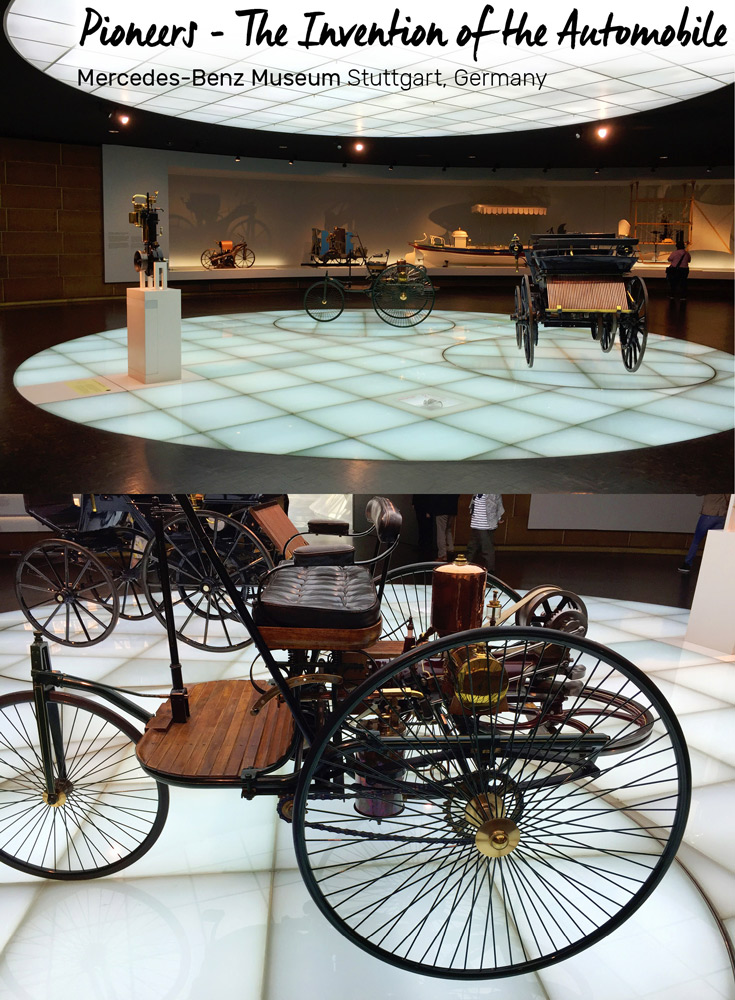
I wonder if the first drivers felt like daredevils? No seat belts, no metal roof, combined with oversized wheels make the prototype look too adventurous for my taste.
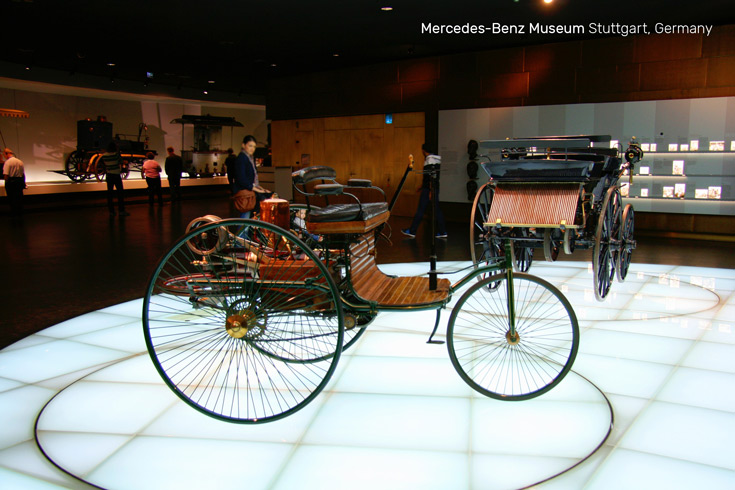
The picture above is of the Benz Patent Motor Car made by Carl Benz, which is the first car in the world with a gasoline engine. Germans invented the first automobile. Henry Ford did not introduce the world-famous Model T until 1908, more than 22 years later. Benz also experimented with engine-powered bikes and carriages, many of them also displayed in this large room.
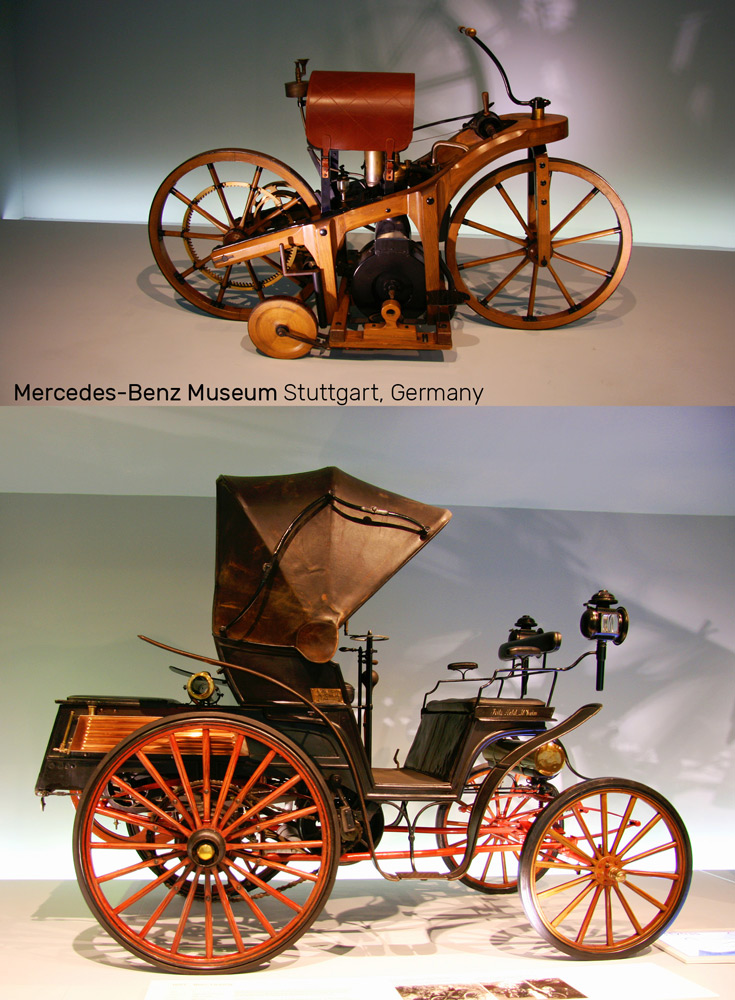
The most surprising take-away from the first room was discovering that Carl Benz in Mannheim, Germany, and 60-miles away, Gottlieb Daimler in Cannstatt, (a suburb of Stuttgart) Germany each independently produced an automobile in 1886. The exhibit in the museum stated that Daimler never met Benz while both were inventing their engine-powered automobiles. Daimler later sued Benz in 1896 for a violation of the hot tube ignition patent, and won.
After Daimlers passing in 1900, his company Daimler Motoren Gesellschaft signed an agreement with Karl Benz's Benz & Cie company in 1926 resulting in a merger and a new company name: Daimler-Benz. But, why is it Mercedes-Benz instead of Daimler-Benz today? The name ‘Mercedes’ was an important automobile series named after Mercedes Jellinek, the first daughter of Emil Jellinek, an automobile entrepreneur and racecar enthusiast. who had created the Mercedes trademark in 1902. Jellinek had bought all his racecars from Daimler and loved the cars so much, he referred to the engine as ‘Daimler-Mercedes’.
After you exit the first Legend room, you step onto a spiral walkway, leading you down a hallway filled with pictures, historic facts and meticulous lighting. Yes, even the lighting is absolutely on target and made me imagine a small army of workers adjusting each and every light until it was perfect. The cars shine and sparkle from every angle, like they just rolled out of the factory.
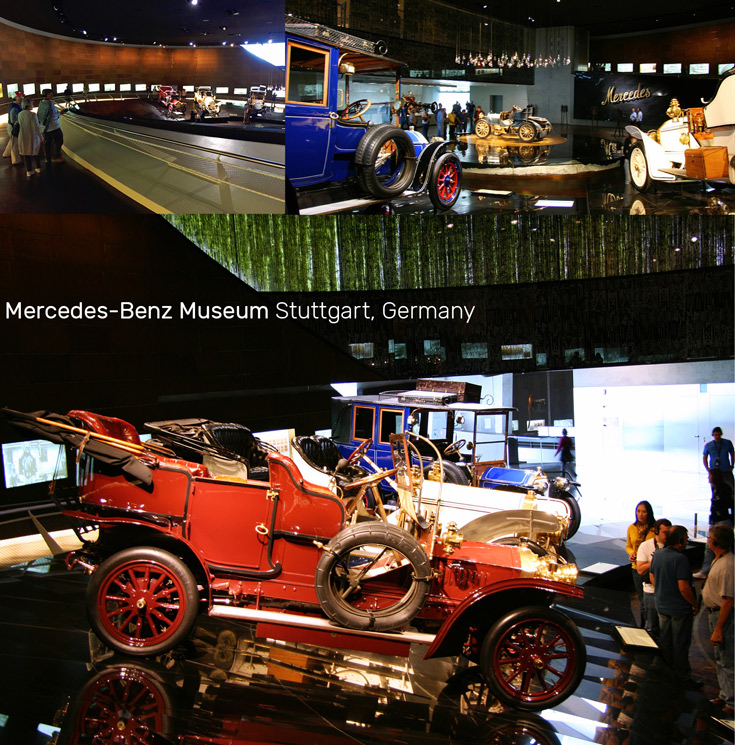
The museum tour is well-thought through, effortlessly guiding you chronologically through history from level to level. After my first visit with Denise I looked up the idea behind the architecture and found that the museum interior was inspired by the double helix structure of DNA carrying the human genome. Click here for an in-depth article on how this ties to Mercedes-Benz’ philosophy. And here is how the Mercedes-Benz Museum is set up architecturally with the DNA next to it.
Legend 2 | Mercedes – Birth of the Brand
After slowly winding down the walkway, and trying to read as many German history notes along the wall, you step onto the Legend 2 platform, titled: ‘Mercedes – Birth of the Brand.’ Here you will find the Mercedes Simplex 40 hp, which is the oldest surviving Mercedes. It looks more like one of our modern cars, instead of an open carriage form that we saw in the first room. The form factor is still box-like, and the wooden wheels probably made an uncomfortable ride.
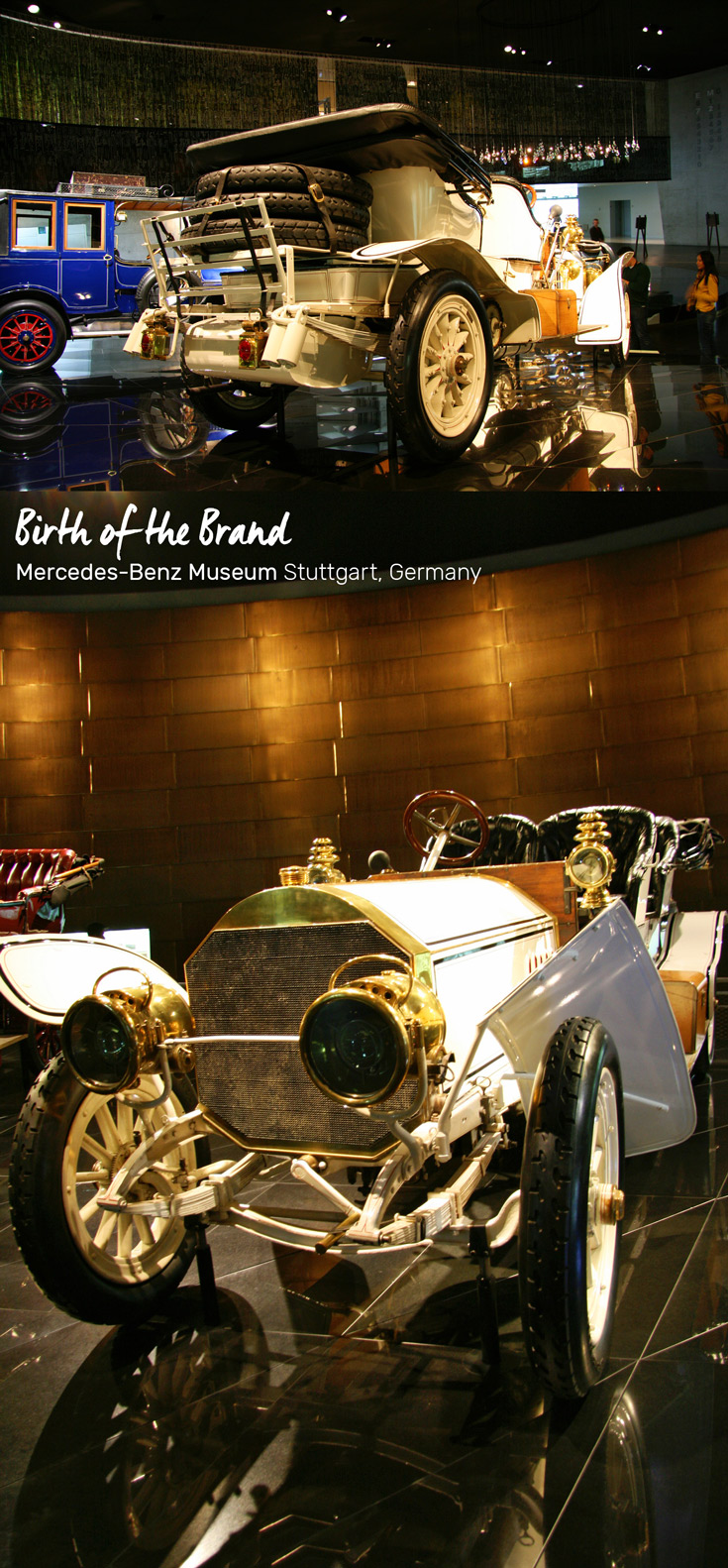
Collection 1 | Gallery of Voyagers
After checking out these treasured and immaculate automobiles under the artificial lights, while the rest of the Legend 2 Platform is pretty dark, you catch a shimmer of daylight from a room off to the right. Next to the chronological and artificially-lit Legend rooms are the naturally-lit Collection exhibit rooms with huge window walls overlooking Stuttgart. The Collection 1 is named “Gallery of Voyagers” showcasing different modes of Mercedes transportation. One of the most elegant cars was the Mercedes-Benz 320 streamlined sedan from the 1930s.
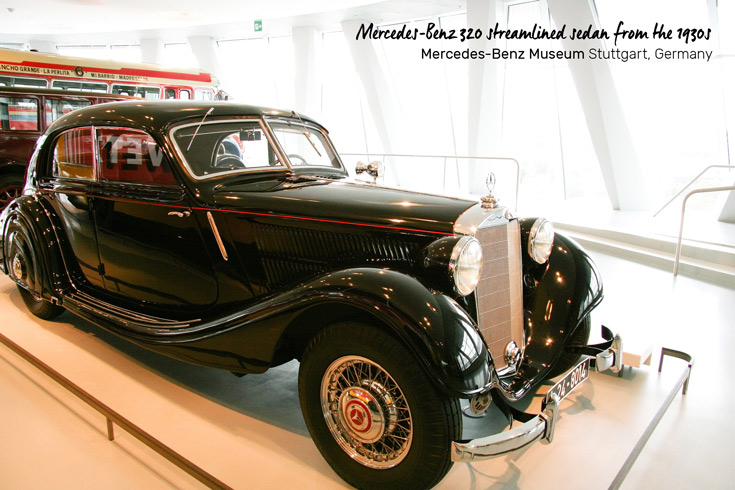
No need to race down the Autobahn with this car, it is a show-stopper. The dark green paint color with a red pinstripe and the huge front grille all come together to impress your friends and family.
The room also shows Mercedes buses, older and newer, including this beautiful O 3500 touring coach with a soft top and glazed roof edges. Its main purpose was tourist travel from Germany to Italy in the 1950s. Even though these buses have been through rough terrain and accumulated thousands of miles, they appear as new and fresh as the cars in the previous room.
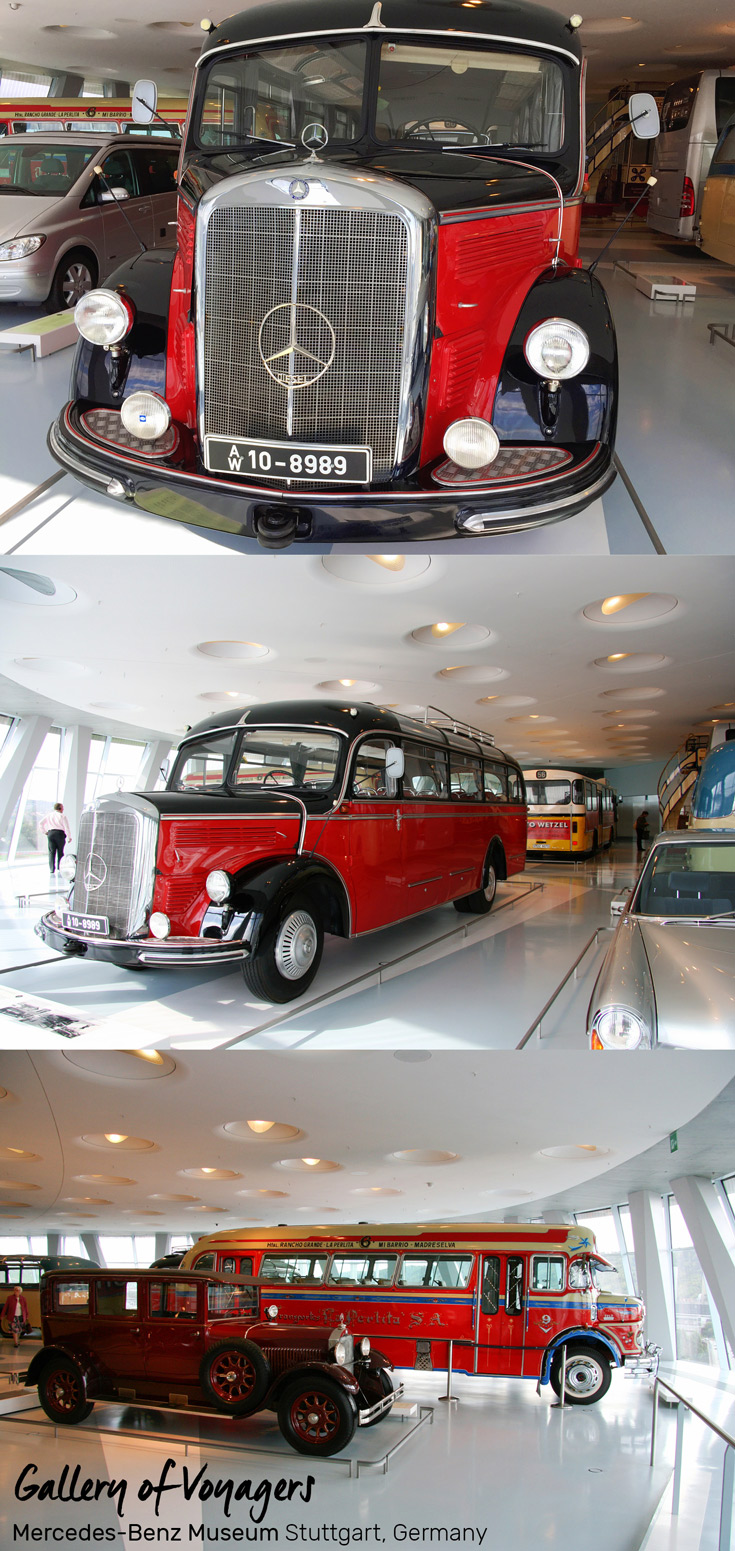
We make our way back through the Legend 2 room and continue down the walkway. Every level has a viewing platform where you can get a sneak peek at the next Legend room below, and also rest on a bench for a moment if you need to pause after all the automobile awesomeness. This is your view, if you look from the Legend 2 down to the Legend 3 room.
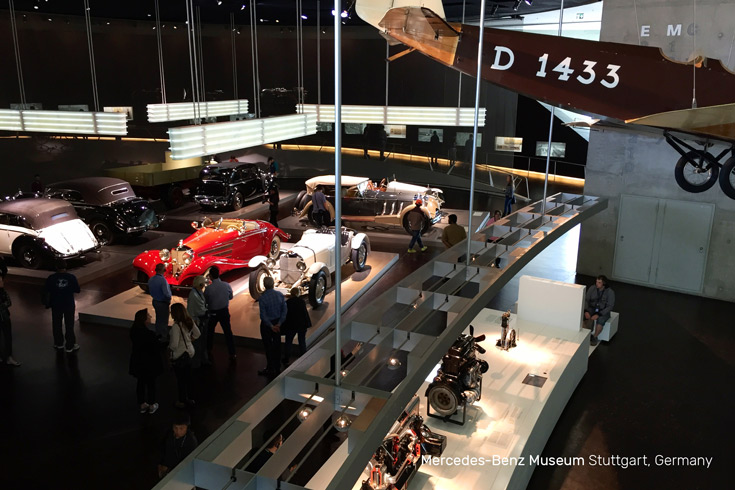
Legend 3 | Times of Change - Diesel and Supercharger
Legend 3 is called “Times of Change– Diesel and Supercharger”, containing my very favorite piece in the museum. I seem to have a weakness for red cars and this one stole my heart.
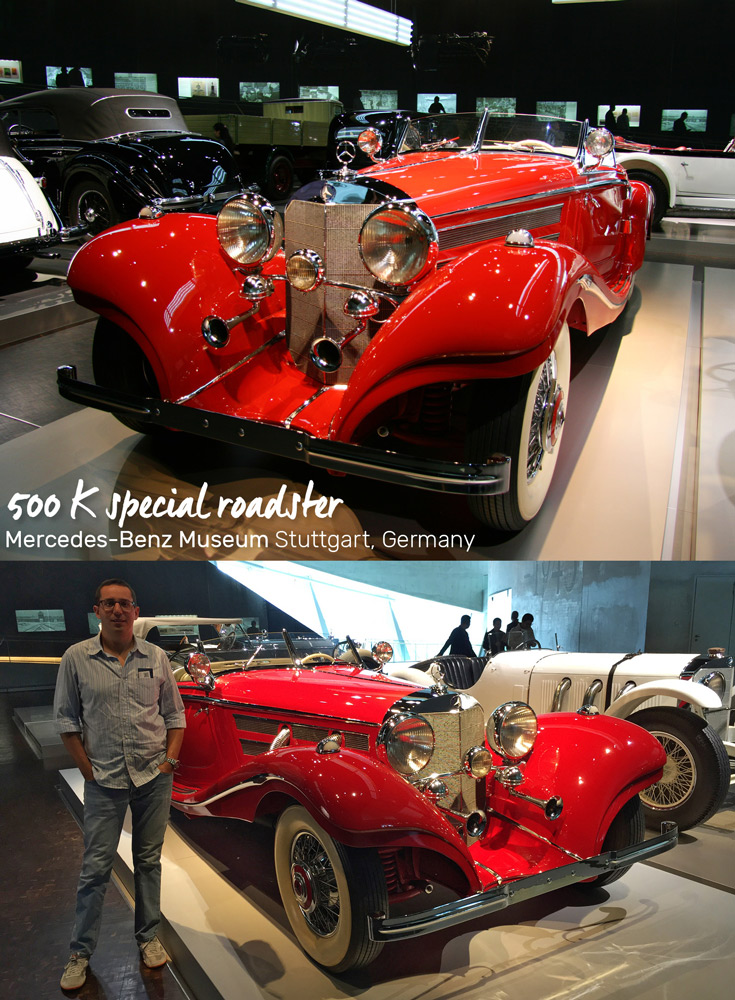
If there is one car I could drive out of the museum, it would be this Mercedes-Benz 500 K special roadster. It was one of the most expensive cars of the 1930s, roughly equivalent to $100,000 of today's money. Only thirty-four were produced from 1934 to 1936. Arguably the most beautiful German pre-war car design with a commanding presence, it is over 17 feet long with only two seats, one for the driver and one for a very happy passenger. The rare auctions of this model top out at five Million USD, so I will have to save quite a bit until I can drive this red beauty out of the showroom. I kept walking around the car again and again. I actually asked my Dad to take a picture of me with the car, something I never do.
Collection 2 | Gallery of Carriers
Still fascinated by the 500 K roadster, we step into the next naturally-lit Collection room, showcasing the “Gallery of Carriers” with trucks, car transporters and a mobile post office that carried three phone booths. The Mercedes-Benz O 10000 mobile post office was very popular after WWII when Germany was trying to rebuild the bombed buildings, whilst trying to stay in communication with family members that lived further away. Not every town had a post office, so the truck would make its rounds, transporting letters and packages from town to town.
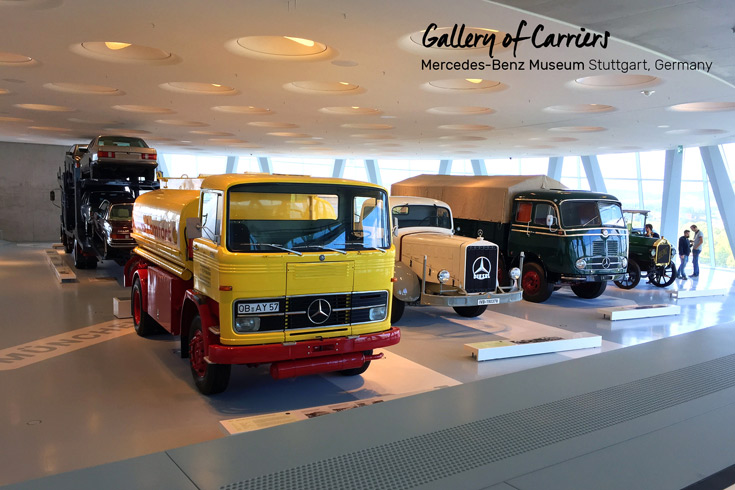
Legend 4 | Post-war Miracle – Form and Diversity
After leaving the room, I can't help but peek at the next platform already, called Legend 4 “Post-war Miracle – Form and Diversity”. It highlights how practically-designed cars morph into becoming more individually styled and aesthetically pleasing. This bird's-eye view is great and gets my Dad and I excited for the cars ahead.
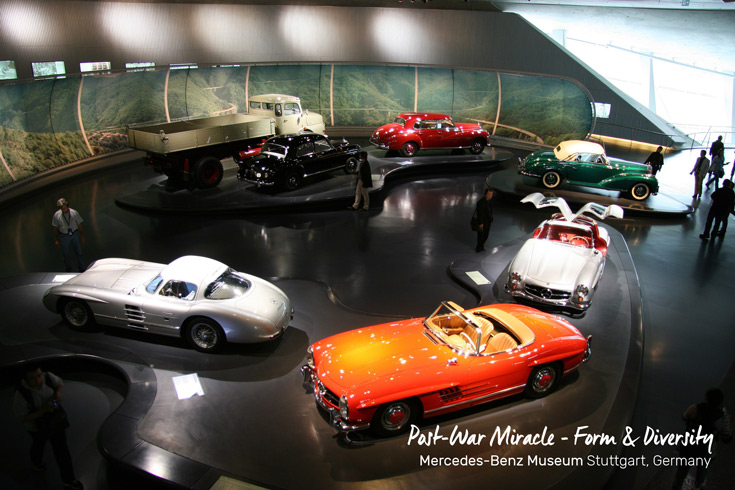
From up there we can already spot the legendary 300 SL coupe in a shiny white color. With its gullwing doors, it stands apart from all the other cars in this exhibit. The high tube, lightweight frame wraps around the perimeter of the car, necessitating the use of the two roof-hinged doors. Take a closer look with this video from the Mercedes-Benz Museum:
Collection 3 | Gallery of Helpers
Next to the stylish roadsters there is the Collection 3 room, “Gallery of Helpers” - basically the dream cars of most little kids.
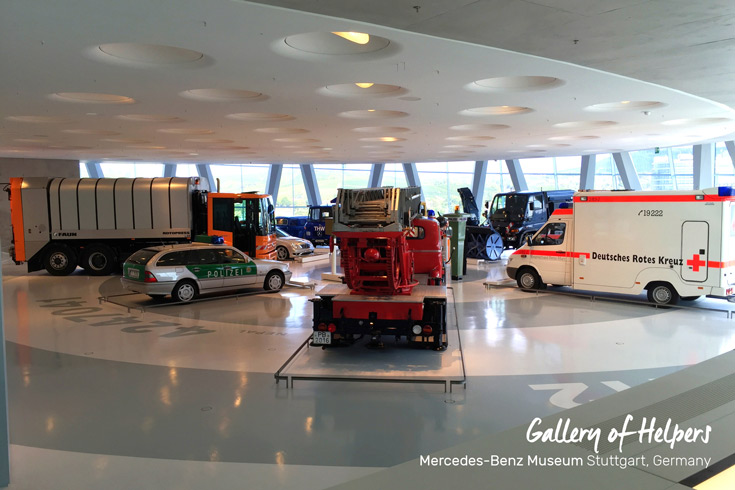
Police cars, fire trucks and ambulance vehicles dominate the space, some classic, some modern. Most of them are essential pieces of any model toy car collection and I remember having several of these models myself. It throws me back to my childhood to see these cars up close and personal, remembering how they rushed by with blinking blue lights on top, sirens howling. I would love to have blue lights and a siren on my current car to get through traffic much faster.
Legend 5 | Visionaries – Safety and the Environment
Dreaming along, we wander down to Legend 5, “Visionaries – Safety and the Environment”. After so many thrilling cars, this was my least favorite exhibit room. The cars from the 1960s and 1970s seem rather bland and boxy, and showcased the development of the passenger safety cell, including newly developed airbags and the anti-lock braking system.
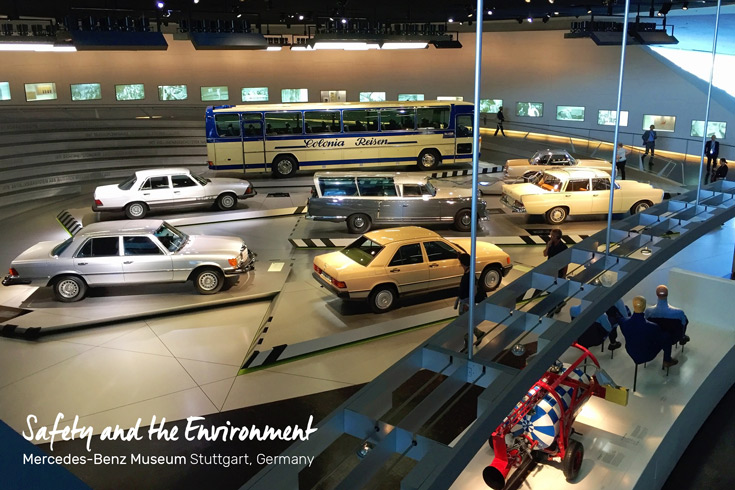
We still look at all the exhibited cars, but this is the room we leave the fastest. Beautiful design fascinates us more than safety features. Not saying that this is not important, but we know there are even more exciting things ahead that need all of our attention.
Collection 4 | Gallery of Celebrities
Another light-filled room called Collection 4 “Gallery of Celebrities” grabs our attention again.
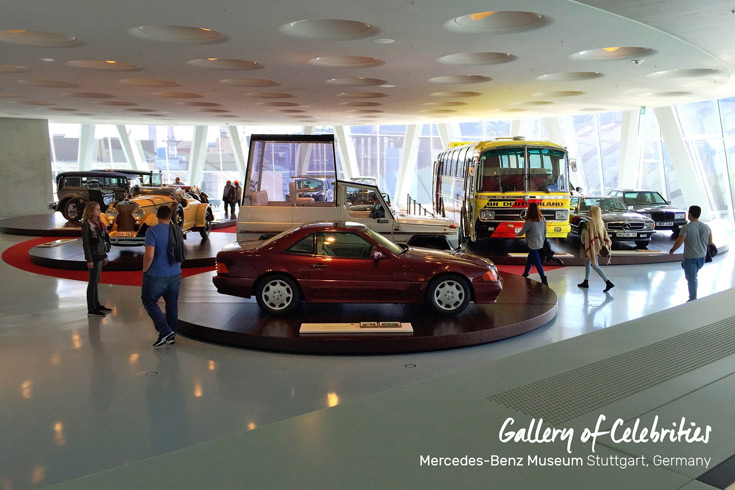
In the middle of the room is a replica of the German soccer team touring bus used when West Germany won the 1974 World Cup. Coming down the walkway I can hear the song that the team sung back then, titled “Fussball ist unser Leben,” which means ‘Soccer is our life.’ Certainly an acquired taste, but hear it yourself:
Since the bus is a replica, you can walk through and sit behind the wheel, making this exhibit a bit more interactive than earlier parts of the Mercedes-Benz Museum, and a fun spot to take a picture!
You can also take a look at a custom-built, glass-enclosed 230 G popemobile, built in 1980 for Pope John Paul in order to protect him from rain and wind. Off to the side is an SUV used in The Lost World: Jurassic Park movie and a red 500 SL owned by Princess Diana. She returned the car to Mercedes-Benz in response to criticism from the British government for not driving a British car. Sad for her, good for the museum.
Legend 6 | New Start – The Road to Emission-free Mobility
The next platform is named Legend 6 “New Start – The Road to Emission-free Mobility”. Looking down to the platform, it does not look very promising, but it turned out to be very interesting.
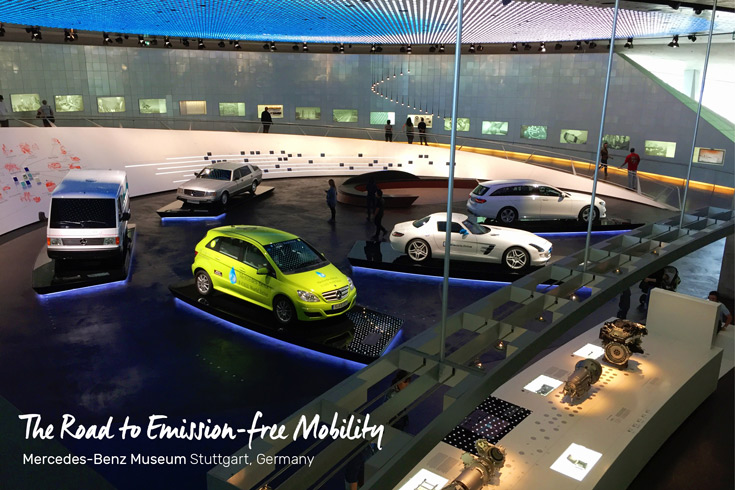
Mercedes has worked on alternative drive systems, for example fuel cells and batteries which do not produce exhaust gases, and ultimately results in less emissions. The green car in the picture is the Mercedes-Benz F-Cell World Drive, a fuel-cell vehicle powered by hydrogen. A central focus of Mercedes-Benz is to have drivers be able to refuel with hydrogen as an alternative to gasoline and diesel. Hydrogen is the lightest of all elements and burns nearly pollution-free, since it turns into heat and water vapor when used. It is easy to forget about this alternative while battery-powered electric vehicles are consistently making headlines.We will have wait to see if hydrogen technology will become more popular. The exhibit definitely made us wonder why this technology is not more popular already, but I guess the current rage are electric vehicles, powered by batteries.
The last Collection room number 5 is used for temporary exhibits. When we visited it in September 2016 it was an homage to the Mercedes-Benz E-Class vehicle series. Before that it was an exhibit for the cars used in the Mille Miglia race series and a dedication to the 60-year anniversary of the Mercedes-Benz SL cars.
Legend 7 | Silver Arrows – Races & Records
Our tour ends at another spectacular room, the Legend 7 “Silver Arrows – Races & Records” exhibit, where a steep banked curve sweeps around the entire wall space, filled with famous, record-breaking cars.
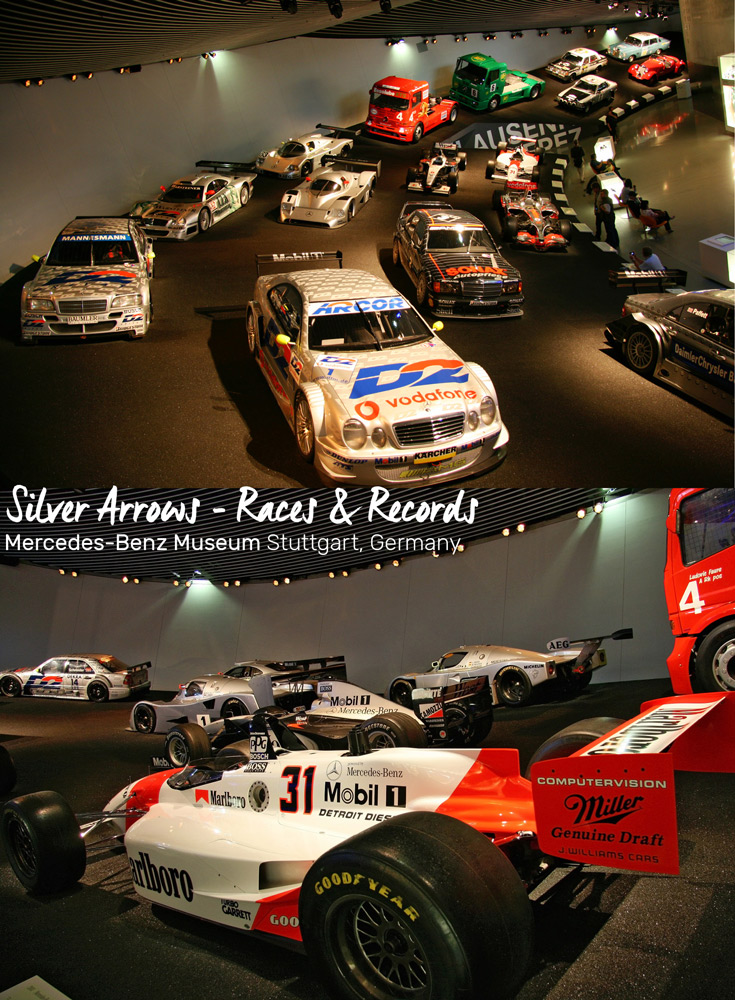
It is an emotional finale to the museum tour and highlights again all the victories of Mercedes-Benz, showing off winning cars and film footage of historic motor races. Dad and I sit down and watch a movie while peering over to the cars hanging on the wall in front of us. I know that the race cars are light, but hanging them up like this makes them seem weightless.
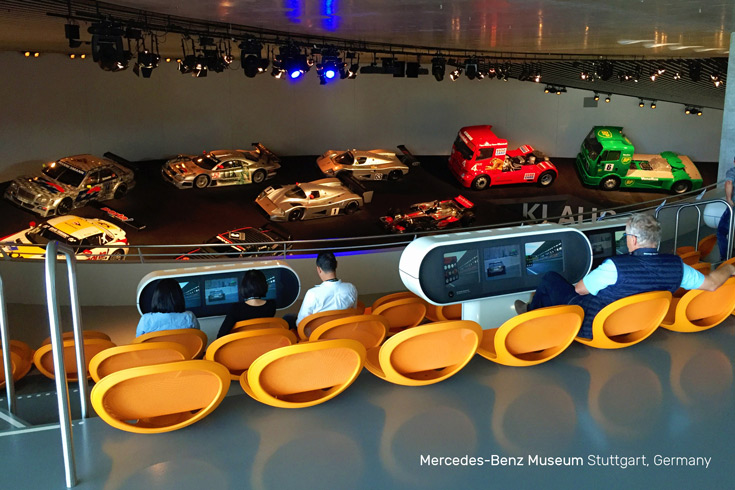
Passing the hanging cars, you can enjoy the thrill of a real race in two racing simulators, or examine two race cars which have their protective metal skin lifted up to reveal the engine and technology underneath. We all know what race cars look like, but rarely do we get to see what is under the metal. Definitely another highlight of the museum since Formula 1 race cars like these are only built in very limited numbers, and seeing them up close and personal like this proves rather tricky without a VIP pass at a race event.
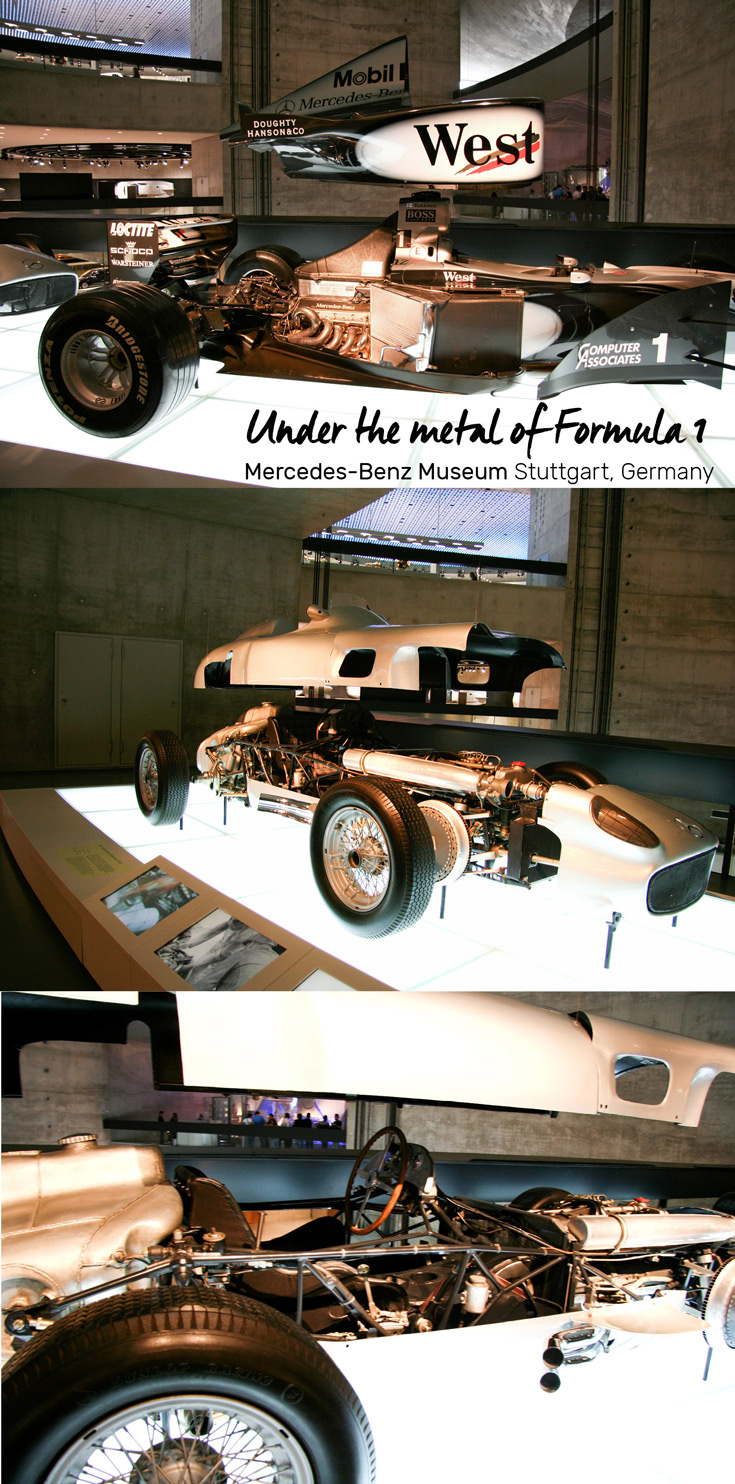
If you have picked up your audio guide, you will have to surrender it at the end of the Legend 7 room, then make your way down a long staircase surrounded by even more Mercedes-Benz cars mounted on the wall or displayed on separate platforms.
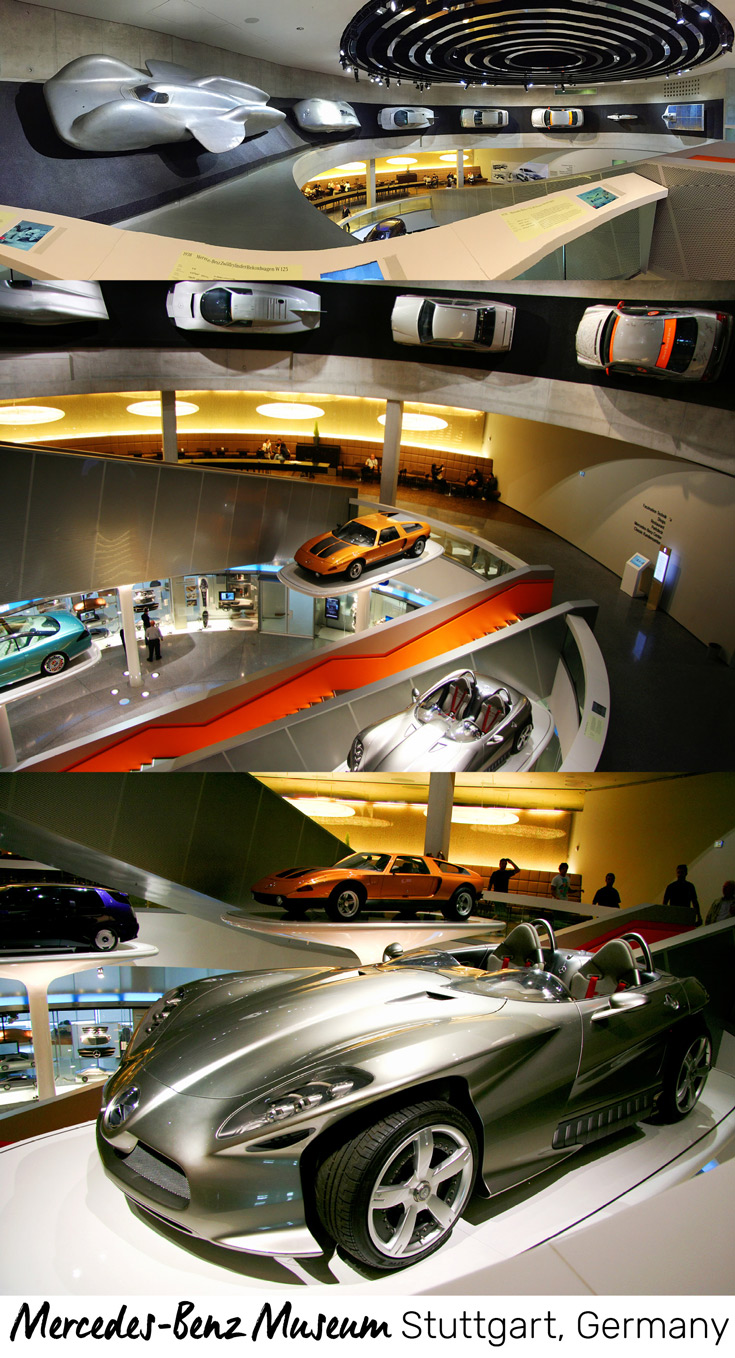
At the end of the stairs you will find a snack bar, Cafébar, where you can get a coffee, soda and small food items at a reasonable price. It was the perfect resting spot to reflect on all the unforgettable impressions we had just seen. I went to the Cafébar both times, with Denise years ago and with my Dad.
But Wait, There’s More
If you think that this is the end of your Mercedes-Benz experience, think again! We head back to the main entrance area and pass the cashiers, keeping left. Down an escalator is the huge museum shop, selling anything and everything connected to the famous car brand. The perfect keepsake for me was the “Buy Me a Mercedes-Benz” book about the museum with gorgeous photos and more background information, perfect to look through when you are back home and the rain is hitting the windows.
I wander through the rest of the shop and lose my Dad in between all the memorabilia. Mercedes-Benz can not only build a great museum, but also a great gift shop. I was impressed smelling several of their branded perfumes. They have more than 15 perfumes they have created since 2012?!
At the gift shop exit is the official restaurant of the museum with black leather chairs and wooden tables. Looks great, but I am not hungry after the cafe earlier, and I let my eyes wander around the rest of the long hall.
All the way at the end of the hall I see a large, light filled room with more cars lining the way. Once Dad finally catches up to me, we walk into a part of the building did not know existed during my first visit with Denise. It is called the Mercedes-Benz Center, where you can look at (and buy) their newest models. Most of them are unlocked and you can sit in them, although a nice sales associate will keep an eye on you while you enjoy all the new car smells.

The cars are shown on three levels, ranging from most affordable, entrance-level cars to most expensive AMG and S-Class models on the third floor. If you are interested in a specific model, you can pick up a detailed brochure on one of the many racks around the cars. It was the perfect ending to an almost 4 hour long visit bringing us to present-day cars, seeing the newest models and being able to play with them a bit. Be warned, you might want to drive off with one of them! The higher the floor, the more loaded the cars are with costly extras!
If you have been to the Mercedes-Benz Museum in Stuttgart, let us know what your favorite part of the museum is in the comment section below.
Going There
Official Website | Mercedesstrasse 100, 70372 Stuttgart, Germany | Tuesdays to Sundays, 9 a.m. until 6 p.m.| For a Day Ticket, 8 Euro
Always double-check your travel plans with the Museum's Website, as details may change after this article has published.
Follow Along
If you enjoyed this article, or these topics sound interesting to you, you'll love our weekly newsletter. You'll receive a free Germany Packing list for signing up, and you'll receive each week's newest posts every Friday. Thank you for reading!

